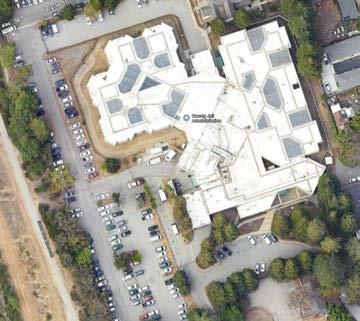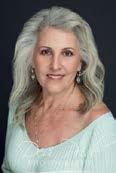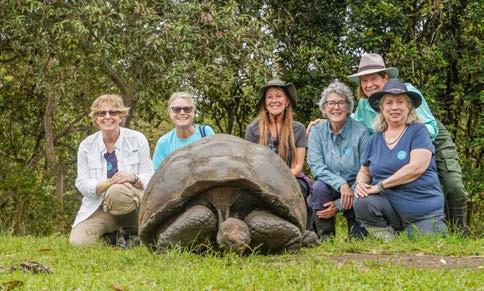




Cabrillo College’s Ethics Bowl team has qualified to compete in the 2025 Association for Practical and Professional Ethics Intercollegiate Ethics Bowl National Competition in Norfolk, Virginia, in February.
At the California Regional Competition at Stanford in December, four of the 27 teams competing advanced to the National Competition.
Cabrillo College was the only community college team to compete against teams from four-year universities including UCLA, UC Santa Cruz, UC Davis, UC Riverside, San Diego State University, and San Jose State University.
Cabrillo was one of only three teams to win all of their first three rounds, advancing to the semi-finals and earning their spot to compete in the National Competition. ... continues on page 4

www.tpgonlinedaily.com



Commander Everett Alvarez, Jr., was the first American aviator taken captive in Vietnam after being shot down near Hanoi. He became the second longest-held U.S. prisoner of war in U.S. history.
Full Story page 5
Santa Cruz Lifesavers
Full Story page 17
Set in the Tennessee mountains, Barbara Kingsolver’s Flight Behavior looks at the effects of climate change on people and the environment.
Full Story page 13











Santa Cruz / Monterey
As the new year begins, we embrace the endless possibilities and fresh opportunities that 2025 brings. The start of a new year is much like stepping into a new home--filled with hope, excitement,and a vision for the future. Whether you’re dreaming of planting roots in a new community, upgrading your space, or exploring investment opportunities, this year holds the potential to make those dreams a reality. Wishing you a year filled with new beginnings, lasting memories, and the joy of finding the perfect place to call home.

Let’s make 2025 a year to remember together! 2 0 2 5












Patrice Edwards
Jondi Gumz
publisher
editor
contributing writers
Michael Oppenheimer
“Ethics Bowl” from page 1
From among the top teams at 12 regionals, only 36 teams were selected to compete in the National Competition.
Cabrillo entered two teams in the regionals. The second Cabrillo team had two wins and one narrow loss to UCLA, finishing in 11th place.
layout
graphic artists
Michael Oppenheimer, Ward Austin
Michael Oppenheimer
Michael Oppenheimer, Camisa Composti website
production coordinator
Camisa Composti
media consultants
Teri Huckobey, Brooke Valentine, Danielle Paul office coordinator
Cathe Race
Jondi Gumz, Manu Koenig, Rebecca Levy, Risa D’Angeles, Christopher Elliott, Joe Ortiz, Rachél Lather, Zach Friend, Tony Tomeo distribution
Bill Pooley, Erik Long

Times Publishing Group, Inc.
9601 Soquel Drive, Aptos, CA 95003
The Times Publishing Group, Inc., publishers of the Aptos Times, a bi-monthly publication, the Capitola Soquel Times and Scotts Valley Times, each printed monthly, Coastal Weddings Magazine, Coastal Home and Garden Magazine, Aptos’ Fourth of July Parade Official Program Guide and Capitola’s Summer Festivals Official Program Guide, is owned by Patrice Edwards. Entire contents ©2025. All rights reserved. Reproduction in any form is prohibited without the publisher’s written permission
PHONE: (831) 688-7549
FAX: (831) 688-7551
GENERAL E-MAIL: info@cyber-times.com
Patrice Edwards: patrice@cyber-times.com
Publisher’s Assistant: assistant@cyber-times.com
Editor: info@cyber-times.com
Calendar Listings: www.tpgonlinedaily.com
Graphics Department: graphics@cyber-times.com
Billing Inquiries: cathe@cyber-times.com
Classified Sales: sales@cyber-times.com
Production: production@cyber-times.com
CHECK OUT OUR WEB SITE AT: www.tpgonlinedaily.com mission statement
We at the Times Publishing Group, Inc. are dedicated to providing a voice for the individuals and organizations in our community while highlighting the outstanding accomplishments of our local businesses. We seek to promote healthy family values through our coverage of youth activities, school news, senior events, community groups and entertainment
“What makes both teams’ success even more remarkable, is that these are first- and second-year students who were competing against teams from other colleges and universities, that were composed mostly of juniors and seniors,” said Claudia Close, Cabrillo ethics instructor and Ethics Bowl faculty advisor. “Throughout the competition, the Cabrillo students were poised and professional, demonstrating exemplary teamwork and good sportsmanship.”
Student teams research, analyze, and construct arguments defending their assessment of the significant moral issues involved in current social, legislative, medical, business, and general interest cases.
“The preparation for the Ethics Bowl is not for the faint of heart,” said 2024-2025 Cabrillo Ethics Bowl team member Olivia McCloskey. “It had us spending hours each day meeting, and studying cases, studying different types of ethical theory, and prepping each specific case. We would use our time discussing our own thoughts surrounding each case, and then doing mock trials to formulate proper arguments. We would spend at least five hours on Thursdays together in the library, debating and pushing each team to be the best they could be. Our team did Zoom meetings nightly, finding time to fit into everyone’s schedules to prepare for our Thursday mocks.”
Students must demonstrate that they have considered the facts of the case, comprehend and can articulate the underlying relevant ethical principles, defend their


claims about how the case should be resolved, and answer challenges to their arguments put forward by the opposing side and the three judges.
In each round two cases are considered, and the students do not know which of the 12 cases they have prepared will be the focus, nor do they know what the question will be. The team presents their argument, responds to the opposing team’s objections, then must respond to the judges’ questions.
In the second half of the round, the opposing team will present on a different case, and the team which presented first must then raise certain points about that presentation. This requires extensive knowledge of the case and the ethical theories, as well as the ability to think quickly and work nimbly with teammates.
For the National Competition, teams will be given a unique set of 17 cases for which they will have less than two months to prepare.
Cases will include questions about space weaponization, parental rights and responsibilities, security issues around automotive tracking devices and doorbell cameras,
tipping culture, hostile architecture, and how to tackle food waste.
Teams compete in four rounds over two days to qualify for the semifinals and finals.
“I am excited to delve into the ethical dilemmas presented in the new cases and to continue working with my team,” said Emma Spath, 2024-2025 Cabrillo Ethics Bowl team member. “We have fostered a strong sense of community, and I look forward to the spirited discussions and collaborative efforts that come with preparing for the national competition. Additionally, I am eager to meet peers from across the country who have similarly dedicated themselves to this process and to engage in collegial conversations born from weeks of hard work and thoughtful preparation.” n •••
Cover Photo: Cabrillo College Ethics Bowl teams (standing from left) — Elektra Shrader, Starr Wenn, Kade Boe, Elena Houle, Olivia McCloskey, Beau Chilson, Texas Young-Shadis, Ashlyn Torres, Emma Spath, Claudia Close (coach), Nancy Brown (cocoach) and Sherri Laning (kneeling) with her support dog, Dezi.



Commander Everett Alvarez, Jr., was the first American aviator taken captive in Vietnam after being shot down near Hanoi. He became the second longest-held U.S. prisoner of war in U.S. history.
Alvarez, the grandson of Mexican immigrants, joined the U.S. Navy in 1960 as an aviator after graduating from Santa Clara University with a degree in electrical engineering. He was a 26-year old Navy pilot based on the USS Constellation aircraft carrier in the South China Sea on Aug. 5, 1964, as tensions were heightening in the area.

He was part of a bombing mission over North Vietnam sent in retaliation after a reported North Vietnamese attack a day earlier on two U.S. destroyers. Alvarez’s Douglas A-4 Skyhawk was shot down in the immediate aftermath of what is known as the Gulf of Tonkin incident that marked the start of a significant escalation of U.S. military action in Vietnam
He endured eight years and seven months of brutal captivity by the North Vietnamese at the Hỏa Lò Prison, known by fellow POWs as the “Hanoi Hilton” where he was repeatedly beaten and tortured. He was released from captivity on Feb. 12, 1973.
Alvarez has said that he survived imprisonment thanks to primarily his faith in God, and the mutual support of the other prisoners who communicated with each other by tapping on the prison walls.
“We had a philosophy that you didn’t ever let your fellows down,” he said in the interview. “If they couldn’t take care of themselves, you took care of them because you knew darned well they would do the same. And we had a goal. We were determined to come home with our personal integrity, our reputation and with our honor.”
He has co-authored two books: “Chained
On Friday, U.S. Rep. Jimmy Panetta (D-Carmel Valley) thanked President Joe Biden for signing the Everett Alvarez, Jr. Congressional Gold Medal Act into law:
“With this legislation, our country formally recognizes Commander Alvarez’s unparalleled courage, resilience, and dedication to our democracy during his time as one of our nation’s longest-serving prisoners of war, “ said Panetta, who is a military veteran himself.
“Commander Alvarez’s unwavering spirit not only inspired his fellow POWs to ‘Return with Honor,’ but also continues to serve as a beacon of hope and determination for all Americans. This Congressional Gold Medal, the highest civilian honor bestowed by Congress, ensures that his legacy and the sacrifices of all POWs and their families are forever remembered.”
Panetta also thanked Sen. Alex Padilla for championing the bill in the Senate, and the co-leads Sen. Cynthia Lummis and Rep. Pat Fallon, as well as to my colleagues in Congress for their bipartisan support. I look forward to the medal’s commissioning and the upcoming ceremony in our nation’s Capitol, where we will collectively honor the life and legacy of an extraordinary Central Coast hero, Commander Everett Alvarez, Jr.” n
Eagle,” with Anthony S. Pitch, about his captivity; and “Code of Conduct / An Inspirational Story of Self-Healing by the Famed Ex-POW and War Hero,” with Samuel Schreiner, about his return and life afterward. His military decorations include the Silver Star, two Legions of Merit, the Distinguished Flying Cross, two Bronzes Stars, and two Purple Hearts.
After returning from Vietnam, Alvarez received a master’s degree in operations research and systems analyst at the Naval Post Graduate School where he is in the Alumni Hall of Fame. He also has juris doctorate degree from George Washington School of Law and is a member of the Washington DC Bar.
“Commander Alvarez” page 7


• Edibles and Fruit Trees
• Native and appropriate plant varieties
• 2 Acre Display & Sculpture Garden


• Gift Certifi cates
• Family Owned & Operated for 30 Years


U.S. Rep. Jimmy Panetta (D-Carmel Valley) has introduced the Monterey Bay National Heritage Area Study Act that would initiate a comprehensive study to assess whether the coastal communities adjacent to the Monterey Bay National Marine Sanctuary qualify for designation as a National Heritage Area.
Such a designation would highlight the region’s unique cultural, historical, and ecological significance while fostering opportunities for local economic growth.
“The Monterey Bay region is home to an unparalleled blend of natural beauty, history, and culture that deserves to be recognized and preserved for future generations,” said Panetta. “We’re taking an essential first step toward recognizing and showcasing our area’s unique identity. This study will help determine the feasibility and community support for this designation, while ensuring that local voices guide the process every step of the way.”
National Heritage Areas are public-private partnerships that leverage federal support to empower local conservation efforts, provide technical assistance, and spur economic development without imposing federal land use restrictions or affecting private property rights. Designation would allow the Monterey Bay region to access additional resources to enhance tourism, preserve historical sites, and promote educational programs while retaining local control over land use and development decisions.

Existing National Heritage Areas include the Sacramento-San Joaquin Delta in California,
the entire state of Tennessee, and regions across West Virginia, Pennsylvania, and Mississippi, Panetta said, showing how these designations can enhance regional identities, promote economic vitality, and preserve invaluable cultural and natural assets.
Original cosponsors of the bill include: Reps. Zoe Lofgren (CA-18), Anna Eshoo (CA16), Salud Carbajal (CA-24), and Kevin Mullin (CA-15).
“The Central Coast is home to some of the most scenic and culturally-significant landscapes, and that includes the Monterey Bay National Marine Sanctuary,” said Rep. Lofgren. “I’m proud to join Rep. Jimmy Panetta in introducing this bill that will allow the National Parks Service to study the coastal area near the sanctuary and determine whether it meets the standards of a National Heritage Area. This designation will help conserve natural resources, engage and educate the public, and celebrate our nation’s diverse heritage.”
“I fully support Rep. Panetta’s efforts to designate coastal areas in San Mateo, Santa Cruz, Monterey, and San Luis Obispo Counties as the Monterey Bay National Heritage Area,” said Rep. Eshoo. “The lands include spectacular beaches, the world-famous Highway 1, John Steinbeck country, and famous landmarks such as Cannery Row and Hearst Castle. These extraordinary areas deserve recognition by the National Park Service so that future generations will have access to these treasures.”
“Heritage Study” page 14
The Times withdrew the article online
“The RTC’s Million Dollar Problem” in order to correct an error that resulted in threatened litigation.
The error has been corrected to recognize that Mr. Jim Weller of Weller & Associates, also known as”landtitleguru. com,” did not perform the most recent Santa Cruz Branch Line corridor boundary assessment.
The work was performed by RRM Consultants: https://sccrtc.org/wp-content/ uploads/2020/06/Replacement-Pages-foritem-21.pdf
Mr. Weller did consult for Union Pacific Railroad Company in 2004 to examine the railroad’s land titles, but that was eight years before the Santa Cruz County Regional Transportation Commission purchased the Santa Cruz Branch Rail Line and he was not engaged to determine the boundaries, or to identify
any encroachments. In fact, SCCRTC has never hired Mr. Weller to do anything, nor has the SCCRTC ever considered or approved any contract with him.
We apologize to Mr. Weller for any harm we may have done.
The Times further hereby states that the intent of the article was never to insinuate in any way that the work Mr. Weller did was problematic or related to the encroachment issues now at hand regarding the two mobile home parks adjacent or to any other properties adjacent to the Santa Cruz Branch Rail Line, and apologizes for any misconception of such.
The only intent of The Times article is to inform the public about the encroachment issues facing the Castle Estates Mobile Home and Blue and Gold Star Mobile Home Parks and other situations of the rail corridor as an important issue affecting the residents in the Community. n
By Jondi Gumz
On Dec. 10, the Santa Cruz County Board of Supervisors approved an ordinance aligning County land use codes with Senate Bill 9 to help meet the state mandate to plan for 4,634 more homes by 2031.
With this change, county property owners have the option to build two-unit residences and have urban lot splits within single-family zones, providing new opportunities to build housing.
SB9 — to eliminate single-family zoning — was proposed by Senate President Pro Tem Toni Atkins, D-San Diego, and signed into law in 2021.
Highlights of the local ordinance:
Property owners in single-family zones, including R-1 Single Family and Rural Residential zones, now have the option to add a second unit or build two residences on a parcel.
which time the application will be deemed approved, bars local governments from denying a lot split application based on its impact on the physical environment and gives the Department of Housing and Community Development oversight and enforcement authority over SB 9.
County spokesman Jason Hoppin said the local ordinance is “expected to contribute meaningfully towards Santa Cruz County’s goal of creating 4,634 new housing units under its Regional Housing Needs Allocation.”

Single-family parcels can be split into two significantly expanding potential housing capacity within existing neighborhoods.
Compliance with Senate Bill 450 (2024), which requires local governments to respond to SB 9 applications within 60 days, after
“Commander Alvarez” from page 5
He served as deputy director of the Peace Corps, deputy administrator of the Veterans Administration (now known as Department of Veterans Affairs) and vice president for government services with the Hospital Corporation of America.
After retiring from government service, he founded and is CEO of the consulting firm Alvarez LLC.
Alvarez and his wife, Tammy, serve on various projects involving wounded warriors, including the Green Road Project at Walter Reed that provides a natural healing environment for wounded service members and their families. He also served for 21 years on the Board of Regents of the Uniformed Services University.

If we paint your interior and/or exterior by January 31, 2025 we will buy the paint.
Both bills were supported by California YIMBY Yes in My Backyard.
The Santa Cruz County housing crisis is rooted in 40 years of policies that failed to produce enough housing.
Since 1980, Santa Cruz County added 80,000 people and only 26,000 housing units.
Santa Cruz County is one of the most expensive housing markets in the U.S. and the crisis has contributed to local homelessness, housing insecurity for local families, and difficulty recruiting new employees for schools, government agencies and local businesses. n

Everett and Tammy have made Rockville, Maryland, their home since 1976. They have two sons who grew up in Rockville. Marc, is an attorney and president of Alvarez LLC. Bryan is a medical doctor and served as a battalion surgeon in Iraq and is a commander in the Navy Reserves. Alvarez is 87. A public high school in Salinas is named for him to recognize his courage and his goal to always look forward. n





Amid extreme wind, drenching rains and a tornado touching down locally following months of preparations for its middle school production of Disney’s “The Little Mermaid Jr,” the Mount Madonna School community came together to find a solution when a fallen tree cut off power and access to the school in the redwoods the morning of the show.
Saturday afternoon’s sold-out show was cancelled, and then the brainstorming began.
Head of School Ann Goewert and Advancement Director Kevict Yen were on campus, having arranged for an earlymorning delivery of an industrial 70,000-watt generator to have on hand as back-up in the event of a storm-related power outage.
The administration communicated with the school community regarding the road closure and show cancellation.
Director Chelsea Otterness voiced plans for adding a second morning performance on Sunday to make up for the missed Saturday show, to provide the student cast with two performance opportunities, albeit back-toback shows making for one long day.
With the unequivocal support of the performing arts team and school administration, Otterness took to social media and email to get the word out about the added Sunday morning show.
“It is amazing to me how our lives bring us moments that we cannot control to see how we respond,” said Otterness. “We have opportunities to resist reality or embrace the opportunities that exist in the reality that is presented before us. Performing arts teach us far more than how to present on stage, such as how to persist and maintain joy regardless of external circumstances.”
The Parents of Mount Madonna Students group took to WhatsApp to elicit the additional parent support needed — including feeding the whole cast during the long, 10-hour theater day that Sunday would become.
“Initially it was feeling very heavy,” said co-producer Jess Vargas. “The school administration led by Ann and Kevict — were amazing. And the POMMS group was amazing. It brought me to tears when parent Karis Gulizia told us, ‘whatever you need, we’ve got your backs 1,000 percent!’ It was just such an outpouring of positivity.”
This outpouring of support was beautiful testament to the spirit that makes Mount Madonna School so special.
“The Mount Madonna School community truly shined as we came together to support the middle school production of ‘The Little Mermaid Jr’,” said Goewert. “From the students’ boundless resilience and positivity, to the parents, staff and friends who showed up and volunteered. This production was more than a show; it was a celebration of teamwork, resilience and the joy of creating something magical together. Thank you to everyone who made it possible; our community is stronger for having shared this journey together.”
Otterness agreed.
“This situation was a beautiful example of so many lessons,” she continued. “The outpouring of volunteerism and inspiration from our community is highly applaudable; our lesson detachment is a hard one, but we — students, parents, faculty and staff — are responding with a ‘solutionary’ mindset and creativity, and are all learning these lessons together, and I believe we have achieved an A+ from the universe.” n

On Dec. 16, the Consumer Financial Protection Bureau released a report describing unlawful activities identified by CFPB examiners across student loan markets.
The report covers violations related to student loan refinancing, private lending and servicing, debt collection, and federal loan servicing.

“Companies break the law when they mislead student borrowers about their protections or deny borrowers their rightful benefits,” said CFPB Director Rohit Chopra. “Student loan companies should not profit by violating the law.”
Student loans represent the secondlargest form of U.S. consumer debt at more than $1.7 trillion in total outstanding balances.
Within the past year, many student borrowers faced challenges, including as 28 million federal student loan borrowers returned to repayment following the end of the Covid-19 payment pause.
The CFPB report details how examiners identified instances of companies engaging in illegal practices in student loan financing:
• Lenders misleading borrowers and failing to carry out their instructions for
refinancing: Refinancing or consolidating federal loans through a private lender results in the loss of important federal protections. CFPB examiners found lenders gave misleading impressions that borrowers who refinance might not lose access to federal loan cancellation programs. Lenders also failed to re-amortize consolidated loans following borrowers’ requests to exclude federal loans.
• Private lenders deceiving borrowers or denying benefits: Supervision found lenders unfairly denied discharge applications for borrowers who were eligible based on Total and Permanent Disability status. Lenders also inaccurately claimed certain borrowers were ineligible for autopay discounts or falsely advertised to borrowers that they could suspend their loan payments if they lost their job but later eliminated this benefit.
• Servicers failing to address claims related to school misconduct: Many private student loans made directly by schools include provisions allowing borrowers to challenge their loans due to school misconduct, regardless of who holds the loans. CFPB examiners found servicers misled borrowers about their right to chal-
lenge their loans and failed to properly consider most borrowers’ challenges to their loans based on school misconduct. The CFPB directed the entities to create robust systems for evaluating borrowers’ claims of school misconduct.
• Servicers distributing contracts allowing illegal collection tactics: CFPB supervision uncovered institutional loan contracts with provisions that would allow schools to illegally withhold students’ academic transcripts or access to classes and other education services in the case of default. Some servicers also falsely threatened students with legal action.
• Federal loan servicers harming borrowers during return to repayment: CFPB supervision observed federal loan servicers failed to provide, for extended time periods, adequate ways for borrowers to manage key loan issues by phone. Servicers also issued deceptive billing statements with incorrect payment amounts and due dates, and debited unauthorized amounts. Significantly, examiners also uncovered numerous problems with how servicers processed borrowers’ applications for income-driven repayment plans.
When CFPB examiners uncover problems, they share their findings with companies to help them remediate violations. Typically, as with some of the instances identified within today’s report, companies take actions to fix the identified problems. For more serious violations or when companies fail to take corrective actions, the CFPB opens investigations for potential enforcement actions.
This report builds on the CFPB’s recent oversight of the student loan market, including the supervisory response initiated during the federal student loan return to repayment.
For more than 10 years, the CFPB has supervised the student loan market for risks to consumers, and has taken multiple enforcement actions for shoddy student loan servicing practices. In November, the CFPB released the annual report of the Student Loan Ombudsman, highlighting the severe difficulties reported by student borrowers due to persistent loan servicing failures and program disruptions. n
Consumers can submit complaints about financial products and services by visiting www. ConsumerFinance.gov or by calling (855) 411CFPB (2372).

By Jondi Gumz
To settle a wrongful death lawsuit filed by the family of Tamario Smith, 21, who died in custody at the county jail, the Santa Cruz County Board of Supervisors approved a settlement of a settlement of $2,210,000 during closed session on Oct. 29, according to Santa Cruz County spokesman Jason Hoppin.
It took several weeks to execute and finalize the payment, he said.
Smith, one of 13 children, moved from Stockton to Santa Cruz County with his family in 2001. He attended Live Oak Elementary School, Shoreline Middle School and graduated from Louden Nelson Community High School. He was a member of the Word of Life Church in Santa Cruz.
He was jailed on a domestic violence charge and had been in custody for four months when he died in solitary confinement May 10, 2020. Initially the county forensic pathologist determined the cause of death to be acute water intoxication, due to the over consumption of water in a short time,

attributed to mental health issues. The death was classified as an accident.
On March 26, 2020, he was found incompetent to stand trial due to extreme psychosis, according to court records.
Medical reports showed he experienced schizophrenia, heard voices in his head, could not participate in his own criminal defense, lacked insight into his own condition, lacked the capacity to make well-reasoned medical decisions, and needed to be closely monitored in an inpatient psychiatric facility.
However, he could not be transferred to an appropriate psychiatric facility due to the COVID-19 pandemic.
Prior being in custody, he had documented mental health episodes, including being schizophrenic and psychotic, experiencing hallucinations and several 5150 commitments for being a danger to himself and others.
On March 11, 2020, Lazar conducted a second interview with Smith, determined that his condition was not improving, so he prescribed an additional medication, Olanzapine, according to court records.
Smith’s family alleged that Olanzapine is well documented to be associated with hyponatremia, a life-threatening condition in which low blood sodium levels can result in death.
Again, Lazar did not order a routine blood panel or review Smith’s prior medical history prior to prescribing additional medication, according to court records. Lazar scheduled a follow up in one week to determine the impact of the new medication, but he never returned, according to court records.

He also had a history of low blood sodium levels, according to court records.
On March 4, 2020, psychiatrist Gerald Lazar conducted his initial intake, determining that Smith suffered from bad auditory hallucinations and prescribing Smith psychotropic drugs, according to court records. Prior to prescribing these medications, Lazar did not order a routine blood panel or review Smith’s prior medical history, according to court records.
Smith’s family alleged that this was in violation of industry standards and jail policies.
While in solitary, on April 21 and April 28, 2020, according to court records, Smith suffered two neurologically related medical episodes showing signs of low blood sodium and overhydration, which his family alleged are symptoms of Olanzapine, according to court records. Smith was also seen on camera drinking dirty mop bucket water containing toxic cleaning fluid and displaying signs of severe mental decompensation, according to court records, but the psychiatrist was not aware of these events.
Thirteen people have died in Santa Cruz County Jail since 2012. That year, the county outsourced medical services to a private forprofit California Forensic Medical Group, which has contracts with 27 counties.

Jail medical services and deaths of inmates were the focus of Santa Cruz County Grand Jury report in 2015.
In 2022, the county paid a $3.25 million settlement related to the death of inmate German Carillo in the jail.
Finding a good provider for the jail has been a challenge.
In 2021, the county switched to Wellpath, one of the incarceration industry’s largest providers of health care, to provide medical services to inmates.
Wellpath, also the provider of medical services at the Monterey County Jail, where monitors found a pattern of inadequate care, filed for bankruptcy in November.
This year, Santa Cruz County declined to renew the Wellpath contract and switched to a new provider, NaphCare Inc., July 1.
Smith’s death led to a call for independent oversight of the Sheriff’s Office and in 2022 the county established an Office of Inspector General, which issued its first report this year.
Asked about the jail (built in 1981) and the new health care provider, Sheriff’s Office spokeswoman Ashley Keehn said, “While we will not comment directly on litigation, the Sheriff’s Office continues to address the challenges posed by an aging facility in need of upgrades and maintenance. We remain dedicated to enhancing the building’s overall condition to create a safer and more efficient environment for both incarcerated individuals and staff.”
“Smith Death” page 14


By Rebecca Levy
Santa Cruz Montessori is marking a major milestone—60 years of inspiring young minds through curiosity, independence, and a love of learning.
Since its founding in 1964, the school has been a cornerstone of Montessori education for Santa Cruz County families, offering an approach to learning that emphasizes respect, self-determination, and learning-bydoing under the guidance of specially trained Montessori teachers.
Located just north of Cabrillo College on Soquel Drive, the main campus spans over three acres, including an administration building, community room, primary and elementary school classrooms, art room, an after-school room, play areas, picnic tables and a large grassy lawn. The school’s toddler and middle school programs are housed at a second location off Park Avenue. Bright and inviting classrooms are thoughtfully organized, with projects and learning materials carefully organized on low shelves to encourage inquiry and investigation.
“What sets Montessori apart is its individualized approach,” said Molly DiPiero, the school’s enrollment director. A former SCM student herself, Molly later returned as a teacher and now has a child enrolled at the school. “Classrooms and lessons are tailored to the developmental stages of the child, whether they’re 3,9, or 14. It’s all about meeting children where they are and supporting their growth in a way that’s unique to them.”
Santa Cruz Montessori was founded by a group of parents, many of whom were instructors at the newly opened UC Santa Cruz and Cabrillo College. The school began in a single classroom at Good Shepherd School in Santa Cruz. By the early 1970s, it had outgrown its original location and moved to the current site, which has expanded significantly over the years. Today, SCM serves

more than 200 students, ranging from 18 months to 14 years old, and employs 60 fulland part-time faculty and staff.
The school is modeled on the methods and philosophy developed by Dr. Maria Montessori, emphasizing the development of the whole child—academically, socially, and emotionally.
“Montessori is built on trusting the potential of the child and fostering curiosity and independence,” said Kim Saxton, SCM’s head of school. With 24 years at SCM, first as a teacher and the last nine as head of school, Kim has seen firsthand the power of this approach. She is also the parent of twins who attended the school.

“Montessori is like a way of living—it’s about how we treat each other, how adults relate to children, and how children connect with each other,” she adds. “It’s amazing to see kids learning in an environment where they have this natural drive to explore and grow. They become creative, critical thinkers who know how to live in society with others.”
Unlike more traditional education where teachers impart information, Montessori teachers — known as guides — encourage independent thinking and help students find answers
for themselves. Each child progresses at their own pace, with guides tailoring lessons to individual needs. Teachers also work to eliminate competition and to create an environment without negative pressures.
Like many private schools, SCM has faced enrollment challenges in the wake of the Covid-19 pandemic. Once home to nearly 280 students, enrollment has declined due to shifting family demographics and the high cost of living in Santa Cruz County.
In response, SCM has expanded its parent programming to encourage stronger community connections. Recent initiatives include parent development workshops and guest speaker events.
“We’ve heard from many families that they value the sense of connection our school offers,” says Molly. “By providing opportunities for parents to engage and learn, we strengthen our community while supporting their children’s growth.”
Tuition at SCM ranges from $2,400 to $3,500 per month, depending on program and attendance. However, the school is committed to accessibility, with approximately 50% of families receiving financial assistance. SCM allocates over $1 million annually to tuition assistance programs.
“Socio-economic diversity is one of our core goals,”
explains Kim. “We’re proud to provide financial aid programs that enable more families to experience the benefits of Montessori education.”
Fundraising efforts further support these initiatives.
As SCM celebrates its 60th anniversary, the school is reflecting on its past while looking toward the future. A historical photo display in the community room highlights its rich history, and special events are planned throughout the year to bring alumni, families, and community members together in celebration. n
•••
Santa Cruz Montessori is located at 6230 Soquel Drive in Aptos. For additional information or to schedule a tour, contact Enrollment Director Molly DiPiero at 831-476-1646 or visit www.scms.org.

Set in the Tennessee mountains, Barbara Kingsolver’s Flight Behavior looks at the effects of climate change on people and the environment.

Dellarobia Turnbow stumbles upon a valley teeming with millions of Monarch butterflies which veered off course in their migration from the mountains of Mexico. As the news spreads, the tiny town becomes the center of media attention, religious fanaticism, and scientific scrutiny.
A team of ecologists investigates; tourists flock to the mountain; opportunists look for ways to make a fast buck; myth-makers invoke religion to explain “the miracle.”
Our Community Reads is a program of the Friends of the Aptos Library in which the community selects a book and then comes together for a series of events related to themes in the book.
Presented with the Friends of the Branciforte, Capitola, Felton, Garfield Park, La Selva Beach, and Scotts Valley libraries, in partnership with Cabrillo College, Aptos High School, Scotts Valley High School, and with the support of the Santa Cruz Public Libraries.
These events aim to create a shared experience that will increase appreciation for community libraries and for local bookstores; foster pride in the experiences this area offers; and the enrichment –– culturally, intellectually, and emotionally –– from the joy of reading!
EVENTS
Tuesday, Jan. 21 • 1:30 to 2:30 p.m.
Field Trip: Monarch Butterflies at Natural Bridges
Join Martha Nitzberg, Interpretive Ranger, and volunteer docent June Langhoff at a Monarch overwintering site.
Learn about their amazing migration and the Methuselah generation that winters on our coast. Weather permitting, take a short, guided walk to the Monarch grove. Binoculars will enhance the experience. Coffee & snacks provided.
Meet at Natural Bridges Visitor Center — 2531 W Cliff Drive (parking fee) Santa Cruz. Register at https:// santacruzpl.libcal.com/event/13810992
Note: There will be an optional stop at Lighthouse Field (another overwintering site) afterward.
Thursday, Jan. 23 • 11 am to 1 pm Book Discussion
Join fellow readers to discuss major themes in depth. Casey Coonerty Protti, owner of Bookshop Santa Cruz, will facilitate the conversation. Sandwiches provided by Aegis Living, Aptos.
The Loft Coffee Sho: 2701 Cabrillo College Drive, Aptos. Register at https://santacruzpl.libcal.com/event/13811178
Saturday, Jan. 25 • 5 to 7 pm
Film: Ice on Fire
Ice on Fire is a documentary narrated by Leonardo DiCaprio that premiered to a standing ovation at Cannes Film Festival in 2019. It explores the potential extinction level effects caused by arctic methane release and new technologies that could reverse global warming.
After the film, Dr. Gary Griggs, Distinguished Professor of Earth and Planetary Sciences at UCSC, will moderate a brief Q&A. Dr. Griggs is Chair of the California Ocean Sciences Trust, and a columnist for the Santa Cruz Sentinel. His latest book is California Catastrophes — The Natural Disaster History of the Golden State.
La Selva Beach Branch Library — 316 Estrella Ave., La Selva Beach.
Register at https://santacruzpl.libcal.com/event/13811658
Wedensday, Jan. 29 • 6:30 pm
Photographers in Nature
Local nature photographers Seraphina Landgrebe, Kevin Lohman, and Bruce Leventhal join fellow photographer Jim Bourne for a lively discussion of how to capture those special images in the wild.
Seraphina Landgrebe has been awarded “Photographer of the Year” by the Professional Photographers Association of the Monterey Bay Area and has operated a successful portrait studio for 30 years in Santa Cruz County.
Kevin Lohman is an award-winning wildlife photographer living in Santa Cruz, with an educational background in marine science.
“OCR Calendar” page 14










FEATURED SPECIALS 6-9PM

chef’s choice tacos with chips & salsa $2 off ALL tequilas
$6 house margaritas, $24 liter margaritas or palomas

BURGERS & BREWS
WEDNESDAYS
chef’s choice burger special bottled & canned beer specials

7500 Old Dominion Ct. Aptos, CA 95003

“Smith Death” from page 10
She added, “To meet the increasing demand for specialized care, the Sheriff’s Office is actively working toward the development of a state-of-the-art facility tailored to support individuals with medical or mental health needs. This new facility will enable us to provide a higher level of care while easing the burden on our current resources and infrastructure.
We also acknowledge the importance of modernizing critical systems within the existing facility. Over the past several years, we have been implementing a comprehensive controls upgrade project, including improvements to call button systems, to bolster safety and communication.
This initiative is progressing as planned and is expected to be completed in 2025, marking a significant advancement in our commitment to improving operations and facility conditions.”
As for medical care, she said, “We are several months into our contract with Naphcare and are pleased with the partnership. The recent
“Heritage Study” from page 6
“The Monterey Bay region is a true gem, rich in cultural, historical, and ecological significance and it deserves to be protected for years to come,” said Rep. Carbajal. “The Monterey Bay National Heritage Area Study Act will help us gauge support for this designation while collaborating with local stakeholders and honoring community voices.”
“Monterey Bay is a unique ecosystem with a longstanding history that supports a robust community and attracts visitors from across the world. California’s coast and Monterey Bay in particular, are an integral part of what makes our Golden State the truly beautiful place that it is,” said Rep. Mullin. “I am proud to join this effort that would include a robust community process to study the feasibility of a Monterey Bay National Heritage Area.”
The National Park Service would conduct the study, which will:
• Examine whether the region meets
“OCR Calendar” from page 13
Bruce Leventhal is an educator, naturalist, and photographer with degrees in biology emphasizing ecology, evolution, and behavior. Their work will be on display.
Radius Gallery at Tannery Arts Center — 1050 River St #127, Santa Cruz.
Register at https://santacruzpl.libcal.com/event/13811548
Saturday, Feb. 1 • 1 to 3 pm
Poetry Writing Workshop
In a creative and supportive setting, poet-teacher Magdalena Montagne will guide you in writing poems inspired by the many themes of Barbara Kingsolver’s Flight Behavior — identity, belonging, climate activism, & social justice. No experience necessary; appropriate for teens and up.
Scotts Valley Branch Library — 251 Kings Valley Road.
Register at https://santacruzpl.libcal.com/event/13811589
Wednesday, Feb. 5 • 6:30 pm
Displaced: How Climate Change is Causing Dislocation and Economic Hardship in Latin America & Beyond
Nick Rowell, Professor of Political Science at Cabrillo College, discusses how natural disasters and severe shifts in weather are destroying human habitats and
Office of Inspector General report highlights a significant reduction in complaints since transitioning to the new service provider.” n
Read the Office of Inspector General Report at https://www.santacruzcountyca.gov/Departments/ OfficeofInspectorGeneral.aspx
Read the 2015 Grand Jury report at https://www. santacruzcountyca.gov/Portals/0/County/GrandJury/ GJ2015_final/MedicalServicesattheJails.pdf

the criteria for a National Heritage Area designation, including its cultural, historical, and ecological significance.
• Assess the feasibility of establishing a local coordinating entity to manage the area in collaboration with community partners.
• Include extensive consultation and listening sessions with local stakeholders across San Mateo, Santa Cruz, Monterey, and San Luis Obispo Counties.
The Monterey Bay National Heritage Area Study Act does not designate the area as a National Heritage Area. Federal law requires a study to be completed before such a designation can be considered.
Should the study confirm strong community support and alignment with the criteria, further legislation would be necessary to establish the National Heritage Area formally.
Panetta said the agency would consult with the community to determine the most appropriate timeline to begin the study, ensuring alignment with local needs and priorities. n

forcing entire communities to abandon their homes and livelihoods, unwillingly joining the growing numbers of climate refugees.
Aptos Branch Library — 7695 Soquel Drive, and via Zoom. Register at https://santacruzpl.libcal.com/event/13811682
For more events visit https://www.friendsofaptoslibrary.org/ our-community-reads.html or read next month’s issue.

On Dec. 12, Santa Cruz County Behavioral Health announced that Mobile Crisis Response Teams are now available 24/7/365 to respond to behavioral health crises for youth and adults across Santa Cruz County, including the cities of Santa Cruz, Watsonville, Scotts Valley, Capitola, and all unincorporated areas.
Yes, that means weekends.
The expanded hours “bring Santa Cruz County in line with a state mandate and our Crisis Now Innovation Project,” Health Services spokeswoman Sandra Hughes said.
“Our services are supported in part by the C.R.I.S.E.S. grant (staffing) and Crisis Care Mobile Units (CCMU) grant (infrastructure),” she added.
The Mobile Crisis Response Team helps remove barriers to crisis support access by meeting individuals where they are — whether that’s a park, school, or other safe location, including faith-based sites.
When a community member calls for the 24-hour Access Line, trained crisis call takers will assess the situation to determine if an individual is undergoing a behavioral health crisis.
If appropriate, a team is dispatched to provide on-site evaluation and intervention.
Once the immediate crisis is stabilized, the team will connect individuals with services and community-based resources.
“Our Mobile Crisis Response Team is staffed with compassionate mental health professionals who understand the diverse needs of our Santa Cruz County community,” said Karen Kern, deputy director of Santa Cruz County Behavioral Health. “With

culturally responsive, bilingual services, our goal is to provide timely and empathetic support during crises, helping individuals feel safe and empowered to continue their care journey. This approach also helps reduce the number of emergency room visits and law enforcement interventions.”
James Russell, director of access and crisis services of Santa Cruz County Behavioral Health, added, “Our partnership with Family Service Agency of the Central Coast has been instrumental in allowing us to swiftly respond and de-escalate mental health crises on a 24/7 basis.”
For information about the Santa Cruz County Mobile Crisis Response Team, see www.santacruzhealth.org/CrisisResponse or call 1-800-952-2335. n •••
If you or someone you love is struggling with thoughts of suicide, reach out for help. You are not alone. Call or text 988 to connect with the Suicide & Crisis Lifeline. Trained counselors are available 24/7 to provide free and confidential support.










On Dec. 11, County Park Friends announced more than $1 million dollars in private funding has been raised for Treasure Cove at Jade Street Park in Capitola — completing a 18-month effort to fund the city’s first-fully inclusive playground.
The goal is to create a place all children can play together without the barriers those with disabilities often experience at typical playgrounds.
PURE Insurance Championship Impacting First Tee, was a key anchor in the campaign by issuing a $250,000 matching grant challenge which members of the community quickly rallied to meet.
Dan Haifley, the community lead volunteer said, “Our team is grateful to all the donors and volunteers who’ve laid the foundation for Treasure Cove. Their generosity will bring much needed joy and laughter into the lives of countless children who’ll get to have a safe place to play alongside their peers. Its true impact will be immeasurable and priceless.”

Kristen Brown, wrapping up her year as mayor, said, “I am thrilled, but not surprised, by our community’s generosity and enthusiasm for Treasure Cove Playground, and by the support and hard work of County Park Friends. This project, specifically designed to be welcoming to all, will truly be a Capitola treasure for generations to come.”
The Monterey Peninsula Foundation, host of the AT&T Pebble Beach Pro-Am and
Community fundraisers over the past 18 months included the Capitola-Aptos Rotary Club’s 2024 Dinner and Auction, Kentucky Derby Party, and Pickleball tournament, the Santa Cruz Sunrise Rotary Club’s annual bike ride, the Boardwalk Chili cookoff, the Surf City Kiwanis annual crab feed, Santa Cruz Gives 2023, and a dinner at Britannia Arms in Capitola.
“Our members are delighted to be part of Treasure Cove, a place where the community can come together and have fun,”


said Lowry Fenton, Capitola-Aptos Rotary 2024 president.
Support also came from private community members in honor of loved ones.
Rich Hamlin wished to donate in memory of his wife, Suzi, who passed away while on vacation in 2023 after being hit by a drunk driver.
Harold Brockman and Cynthia Smith fulfilled Harold’s dream to honor his first wife, Patricia, who passed away 28 years ago.
Notable foundation support for the project included Kaiser Permanente, donor advisors at the Community Foundation Santa Cruz County, and the Soquel Union Elementary School District.
“County Park Friends is humbled by the breadth of support from our community to make Treasure Cove a reality,” said Mariah Roberts, executive director of County Park Friends. “This is the type of community building project our organization loves to do and it’s only possible
because everyone steps up to play their part and make it happen.”
The City of Capitola plans to secure any remaining necessary funding by early spring, 2025, and to bid the project that fall. Groundbreaking could be as soon as winter 2025. n Treasure Cove logo created by Verde Designs and County Park Friends





By Jondi Gumz
When the end of the Santa Cruz Wharf collapsed into the ocean on a day when one of the biggest swells was expected, two city of Santa Cruz lifeguards patrolling on a jet ski had to act fast — and they did, saving two lives.
Lt. Isaiah Mullen, a lifeguard since 2016, born and raised in Santa Cruz, trained with Junior Guards, and his partner, Lt. Sam Hofmann, an East Coast transplant and a lifeguard since 2010, were called in to work on Dec. 23, two days before Christmas, specifically because of the big swell creating the potential for a need to rescue surfers or onlookers.
Of course, they had no clue that the part of the 2,701-foot wharf, which was being repaired, would drop into the ocean.
They shared their rescue story — calm, cool and collected — in a video posted on Facebook by the County of Santa Cruz.
They were on the Cowells Beach side of the wharf, onequarter of the way to the end, when intuitively Mullen looked to the end of the wharf.
Perhaps it was the cracking of the pilings that hold the wharf.
With that glance Mullen saw the wharf collapsing into the ocean.
The two lifeguards pointed their jet ski in that direction. Mullen put his fins on, just in case.
As they approached, Mullen could see “the true scope of what had happened,” the wharf in the water, and “two individuals standing on the wreckage waving us down for help.”

and the debris was heavy in the water, so the lifeguards split up.
Mullen swam in for one; Hofmann successfully went after the other.
“I wanted to get the individual out as quickly as possible,” said Mullen, who couldn’t tell if the wrecked structure was going to fall apart or get pushed into the pier.
Because of the debris in the water, the jet ski couldn’t get close enough for one rescuee to climb aboard, and the tide sucked in, making for a bit of difficulty.
Navy career, also saw the splash of the wharf, an island with lamp posts bobbing in the water.
“It was pretty surreal,” he said.
For those drawn to big waves, he gave a warning, “When it’s big, that’s when it’s fun but know your limits.”
The Santa Cruz Wharf, built in 1914 and owned by the city, and more than 20 restaurants and shops along, has been closed since Dec. 23, putting an estimated 400 people out of work.
The Wharf was weakened by the demolition of the Dolphin restaurant, damaged in a December 2023 storm.
With 150 feet of the wharf gone, City Manager Matt Huffaker said the damages are being assessed.
He said he couldn’t speak with confidence that rebuilding this section of the wharf is appropriate.
Those rescued were construction workers working in wharf repairs regulated by the California Coastal Commission and for which the city was given a window of September through March, to protect seagulls nesting in the wharf.
Santa Cruz County Supervisor Justin Cummings, who represents the First District, was voted chairman of the Coastal Commission board for 2025.

One was closer to the pier, the other was toward the end,






“Managed to get him out with the tube,” Mullen said. Hofmann, a surfer and waterman who followed his mom’s





























Among the casualties of the swell were commemorative benches families paid for, historic artifacts, restrooms, and a crane that was in use for the repairs that fell to the sea floor and must be retrieved.

Anyone who finds benches or artifacts can call the city Parks and Recreation office, 831-420-5270. n



By Christopher Elliott
Leah Frazier is tired of being travelshamed.
She recently posted a video to her social media accounts about her adventures in Dubai, which included attending brunch at one of the Gulf state’s legendary luxury hotels.
“The video showed a group of travelers having the time of their lives,” says Frazier, who runs a marketing agency in Dallas.
But the comments were angry and demeaning. Why did she fly halfway around the world just to eat brunch? How could she be so culturally insensitive? Wasn’t she embarrassed by her behavior?
“I got a lot of ‘shame-on-you’ responses,” she recalls.
Frazier is not alone. Although travel shaming is a practice that’s as old as travel itself, it’s been picking up some momentum lately. During the pandemic, many Americans mistakenly thought they had acquired a license to tell each other how they could travel. And then growing climate change awareness lit a fire under this phenomenon. Now, anyone who travels could get travel-shamed. That includes you.
If someone scolds you for traveling too much, they’re travel-shaming you.
The shaming can take several forms:
• Environmental travel shaming. Think Swedish flygskam, which became trendy just before the pandemic. Most air travel harms the environment, so there’s plenty of embarrassment to go around.
• Political travel shaming. That’s where you visit a hostile country such as North Korea or Iran or a place with a large indigenous population and a history of exploitation.
• Animal travel shaming. If you go on a Big Five hunting expedition in Africa or even do a swim-with-the-dolphins experience, you might undergo shaming from those concerned about animal welfare.
A recent study of travel shaming by Temple University researchers found the embarrassment caused by travel shaming can make people change their behavior. But it notes that the carrot works better than the stick; what it called “positive framing” of any concerns was far more effective. But maybe not as much fun.
And make no mistake, travel shaming in the age of the internet is fun — at least, for those doing the shaming. Even airlines do it. If you’ve read the comments section of any travel blog, you know what I mean. So what’s the solution? Experts say the trick is a little rhetorical jiu-jitsu, choosing


your destination carefully and knowing what to say if someone tries to dress you down.
The moment someone comes at you with a finger-wagging, you want to respond. Of course you do! But take a deep breath and let them speak.
“Consider the reason the person is attempting to shame you,” says Abbe Depretis, who teaches business communication at Carnegie Mellon University. “Are they jealous that they can no longer afford to travel or take time off work and they are lashing out? Are they concerned about the rights of the people in the destination or about the environmental impact of travel?”
Once you understand where the person is coming from, you can have a productive conversation, adds Depretis.
That’s what Jay Ternavan, founder of Jayway Travel, recommends. For example, you might catch some flak for visiting a place like Dubrovnik, Croatia, a beautiful walled city on the Adriatic with a reputation for being overrun by cruise ship passengers.

“Rather than contributing to the strain on Dubrovnik, why not explore hidden gems like Rovinj, Šibenik, and Korčula?” he says. “These charming places have rich histories, stunning architecture, and equally beautiful
coastlines — all without the overwhelming crowds.”
One thing is for sure: If you do any kind of traveling in 2025, you will probably get criticized by someone. Shel Horowitz, who specializes in advising businesses on environmental issues, advises you to have a diplomatic answer ready.
“I tell them my travel allows me to bring back solutions from other countries,” he says. “For example, in Iceland, I discovered the country is almost entirely powered by renewable energy. But it also gives me a deeper understanding of the environmental issues others face in different parts of the word.”
As someone who specializes in writing about sustainability and tourism, I’ve used Horowitz’s method before. Yes, my flights emit CO2 just like everyone else’s, but my trips also bring a greater awareness of the environmental challenges the tourism industry faces.
Confession: If anyone deserves to be travel-shamed, it’s probably me. I’m constantly on the road, and I fly everywhere. This year alone, I’ve lived on five continents.
Ironically, I face a different kind of travel shame from my journalism colleagues, some of whom travel even more than I do.
There’s an unwritten rule that you have
to have visited at least 100 countries to call yourself a travel expert. When I meet a colleague, we often compare notes. And when they say, “Have you ever been to X” — and I say “no” — I admit I’m embarrassed.
So we prod each other to travel more.
But when people ask me how I can justify all that travel, I remind the shamers that humans were nomadic until about 12,000 years ago. A peripatetic lifestyle is more traditional than a sedentary one. So please don’t shame me for being normal.
Frazier, the woman with the Dubai video, said at first the shaming comments upset her. She insists she wasn’t being wasteful or disrespectful. She and her friends were just having a good time.
But as she continued to read the comments, Frazier realized that people were making assumptions about her that were wrong. She started to answer the comments but then realized the shamers were probably just jealous because they didn’t get to visit a luxury hotel in the United Arab Emirates.
“So I just let them go,” she says. n
Christopher Elliott is an author, consumer advocate, and journalist. He founded Elliott Advocacy, a nonprofit organization that helps solve consumer problems. He publishes Elliott Confidential, a travel newsletter, and the Elliott Report, a news site about customer service. If you need help with a consumer problem, you can email him at chris@elliott.org.
Illustration by Dustin Elliott

By Joe Ortiz

Editor’s note: This is the fifth in an ongoing series by Capitola creative Joe Ortiz.
Perhaps not surprisingly, the craft of acting can help us learn to lead more creative lives.
Our daily interaction with friends and loved ones is in fact an “acting out” of our most authentic self — even if the most inspired version shows up only on our better days. As a disciplined extension of this everyday experience, the dramatic arts can shed light on how humans create.
In crafting characters for the stage, Russian stage director Konstantin Stanislavski taught student actors to lift themselves out of everyday life and into their imaginations by using their past experiences as a guide for revealing emotion. His concepts grew into what is considered Method Acting today. The practices were appreciably modified during the ‘30s and ‘40s by Sanford Meisner, who taught actors to focus less on traumatic personal experiences, and more on being in the moment and responding authentically to their fellow actors on stage.
Both of these methods are still used
today in training actors for live theatrical performances and for cinema. They not only suggest good advice for everyday living but can also help artists cultivate stronger creative expression in a variety of art forms.
In Stanislavski’s immersive formula, actors are asked to combine a movement or gesture on stage with the recollection of an incident that arouses feelings in their own lives. For example, if, when an actress was a child, she saw her father light a matchbook on fire and flash it in her mother’s face, then hurl an ashtray at her, those objects might call up terrifying sensations in the present. Automatically, the ashtray becomes a potential vehicle for dramatic effect in a scene where the actress must express intense emotion.

The Meisner technique would further emphasize that by using such objects and one’s surroundings on stage as a means to remain in the moment and cultivate deep listening, the actor’s physical movements will unfold without the need to strive for artificial high drama.
never attain the personally-invested kind of work created by living, breathing artists who possess their own rich and unique history. For example, no computer-based intelligence can use what memoir writer Mary Karr describes as “carnality” — details drawn from an individual writer’s senses of taste, smell, and touch — to bring a narrative to life.


I think both Meisner and Stanislavski would agree that these principles extend beyond theater to other creative fields. For example, if the actress mentioned above were to paint a still life containing an ashtray, the object would generate an “emotional memory,” which might be expressed unconsciously in the painting.
Practicing artists often summon up the actions and emotion-filled objects of their past to embellish their art with sensations sparked by personal experience. “Write what you know” is one prevailing mantra. For this reason Artificial Intelligence might
Yet, any recollected memory we might use to trigger emotion doesn’t have to be a painful one. In fact, this original hallmark of Method Acting has received criticism in recent years because actors who use the technique of recalling traumatic memories can become psychologically drained after a series of intense performances. Without any such risks, we can use the practice to reach for emotionally charged expressions in our writing, painting, or any other art form.
When you work on an important creative project, you’ll find that the most effective details come readily from your experience. If you trust personally relevant facts and images — and dig even deeper for them — the emotional impact of your work won’t have to be fabricated.
Instead, your expression will be colored with meaningful imagery and your drafts of stories, poems — even emails, lists, and texts — will resonate with a personally charged conviction. n
With nearly 50 nominations submitted, the Santa Cruz Works Board of Directors faced the challenge of narrowing the field to a maximum of 10 finalists. The selection criteria were as follows:
• The nominee’s business must be based in Santa Cruz, Monterey, or San Benito County.
• The nominee must have made a meaningful economic, cultural, or social impact locally or globally.
• Demonstrates exceptional innovation or entrepreneurship through groundbreaking products, services, or business models that address current or future challenges.
And the awardees are:
Dr. Chris Benner / UCSC
Dr. Chris Benner’s groundbreaking work champions equity and economic opportunity by reshaping narratives and policies to highlight collaboration and mutuality. Challenging neoliberal norms, his Solidarity Economics framework has driven transformative initiatives like the Salinas Inclusive Economic Development Initiative and the state-wide Community Economic Mobilization Initiative, and helped influence

California’s $600M Jobs First program, fostering justice, innovation, and impact.
Cate Miller / Chiorini, Platt & Jacobs
Cate is a dynamic finance professional driving positive change in Santa Cruz. At Chiorini, Platt & Jacobs, LLP, and previously as a partner at Summit Accountancy Group, she led with innovation and integrity. As an accounting professor at CSU Monterey Bay, she’s shaping the future of finance through mentorship and education.
Josh Metz / DART
Executive Director and co-founder of DART (mbdart.org), Josh exemplifies visionary leadership, driving innovation and economic resilience in Monterey Bay. From securing Joby Aviation at Marina Airport to launching apprenticeship programs and securing $3.5M in funding, his dedication to transformative partnerships and workforce development is building a thriving, future-focused community.
“Santa Cruz Works Awards” page 26
A Wonderful Opportunity for Seniors
Dec.13 was the last day of the semester. Our work was up on the walls. We were tired but ready to engage. Most of us agreed that the semester was too short!
In this art class at Cabrillo College, about half of us were over 60! We tried new things. We encouraged each other. The class was stimulating and challenging, but we were not worried about grades! Cabrillo gave us this opportunity to explore and pursue our interests. One of the best things about the class was the sense of comradery.
Fellow seniors, at Cabrillo, the cost per unit is not high, and registration is not really expensive, plus it carries over if you keep taking classes.
The instructors here are real teachers, not as focused on publishing as teachers are in other kinds of colleges. There are classes in many subjects, amazing facilities (a pool, a greenhouse [hydroponics!], a planetarium) and great equipment (3D printers, laser cutters). But perhaps best of all is the sense of community here.
If you wonder where **your** community is, maybe it’s right here at Cabrillo, where it’s all for one and one for all!
Registration for Spring 2025 classes ends Feb.2.
— Celine Grenier, Capitola
A Request to Sheriff Chris Clark
Congratulations on your new role as Santa Cruz County Sheriff. If I may be so bold, may I ask you one important question?
In your new role, are you committed to abide by Title 8? Title 8 United States Code 1324 (iii): It is a felony if you knowingly harbor and conceal an illegal alien from immigration authorities.
The reason I am asking you this is that I, along with other citizen residents of Santa Cruz County, no longer feel safe here.
As a candidate for the City of Santa Cruz District 4 in 2022, and as a homeowner in the Unincorporated District 1 of Santa Cruz County under the helm of Supervisor Manu Koenig, it would be quite incomprehensible to me for a person in your position to not uphold Title 8 for the reasons I outline below:
Catch and Release — to knowingly release criminal aliens back into our community poses health and safety risks to our residents by choosing to “conceal” these criminal aliens and placing them back into our general population.
Title 8 is your legal obligation to proactively notify federal authorities in these
In your new role, are you committed to abide by Title 8?
cases. By removing these individuals from our general population, you will aid to substantially reduce:
General Crime — including, but not limited to, property damage, home invasions, theft (automobile, bicycle, retail products, etc.), child trafficking, assaults, rapes and murders.
By failing to adhere to Title 8 and choosing NOT to assist Federal immigration agents in this regard, you will not only be breaking federal law, but you will also be placing the safety of members of the Santa Cruz County community at further risk–residents who you have sworn to protect and serve.
Illegal Narcotics — as you know, Santa Cruz County has a major drug epidemic.
Our homeless community has been especially hard hit by it. The number of annual overdoses is staggering. Fentanyl is now being laced into just about every street drug. It is cheap, plentiful and killing our community.
By ignoring your Title 8 obligations, you will be directly responsible for many of these future overdose cases and the related gang activity associated with the distribution of this deadly narcotic. Fentanyl and other narcotics like heroin and methamphetamine have permeated our schools and the lives of our children.
Our young people and our homeless communities are especially vulnerable and are relying on you to make a real impact in cleaning up our streets. Title 8 is one of the most powerful tools in your arsenal where you can make a real difference. By choosing to “knowingly harbor and conceal” these individuals from Federal law enforcement and releasing them back into our community, it will become immediately apparent that you are NOT here to protect and serve us, but, in fact, to further harm us.
By not upholding Title 8, you are just another puppet of the politicians here — and we have had a long history of puppets in law enforcement in Santa Cruz County, Sheriff Clark.
It takes true courage to do the right thing. The tide is changing. You just have to care about the people here and help us to feel and be safe again.
Please go on the record in regards to your role and commitment in support of Title 8.
Believe me, the majority of the Santa Cruz County community will have your back if you have ours — and I’ll be the first to stand up for you.
— Greg Hyver, Santa Cruz Editor’s note: When asked by CapitolaSoquel Times, Sheriff Clark provided this response: “California’s law enforcement response to immigration is shaped by state policies. The state has adopted several measures that provide clear guidance in regard to our office’s collaboration with Federal Immigration enforcement.” n






By Manu Koenig
Editor’s note: Supervisor Manu Koenig posted this in October to explain the plethors of new housing development. The state push has led to creation of Catalysts for Local Control. See https://catalystsca.org/
Many of you who live near these proposed projects have asked how we can reduce the number of units or the size of the buildings. The County is extremely limited in its ability to halt or substantially alter these projects due to many recent changes in state law. Here’s an overview of just a handful of the recent laws that have changed the housing landscape.
SB 7 — The Housing + Jobs Expansion and Extension Act (2021)
AB 3194 — The Housing Accountability Act (2018)
SB 35 — Streamlined Affordable Housing Approval Process (2017)
AB 1763 — Affordable Housing Enhanced Density Bonus (2019)



and Thurber & Soquel align with the plan that the state required us to adopt. In the case of Thurber Lane, the 6.26-acre parcel is zoned for high density residential and commercial projects with up to 281 units. The 181 units proposed are well within the allowable range.
Our Housing Element process required us to plan for thousands of new units and we concentrated this growth along transit corridors, like the area where this development is planned. This allowed us to avoid placing dense developments right in the middle of single-family neighborhoods.
In other words, the State of California is serving as coach, referee and scorekeeper when it comes to housing in our community. They’re coaching us to include more housing in our zoning plan (SB 7); calling foul if we try to deny a project that was zoned for (AB 3194); and simply changing the score by forcing us to approve projects if we don’t comply (SB 35).
And the state laws keep coming. In September, the Governor signed 26 new housing bills. These new laws impose monetary penalties on cities and counties that fail to adopt housing element revisions or approve housing developments. They also reduce reduce regulatory barriers, promoting housing near transit.
We need look no further than the City of Santa Cruz and the approval of the 831 Water Street development to see an example of these laws eliminating local control. Initially, the Santa Cruz City Council denied the project in October 2021, citing concerns about the clustering of affordable units, slope regulations, and incomplete environmental assessments.
However, the developer resubmitted plans under SB 35, the state law that limits local governments’ ability to deny housing projects if they meet specific criteria, including affordability requirements. The project ultimately gained approval in December 2021 after revised plans addressed some of the council’s earlier concerns, including redistributing affordable units across two buildings. The threat of a lawsuit from YIMBY Law, which advocates for compliance with state housing laws, also influenced the council’s decision to move forward with the project.
The proposed projects for 41st & Soquel
It’s been asked, why here in Live Oak and Soquel? Why not put these projects somewhere else like Downtown Santa Cruz or Watsonville?” The State’s answer is — all of the above. Thurber Lane is located in the unincorporated part of the County. The unincorporated county received a state Regional Housing Needs Assessment (RHNA) number of 4,634 new units. The four incorporated cities also received allocations of thousands of units as follows:
• City of Santa Cruz: 3,736 units
• City of Watsonville: 2,053 units
• City of Capitola: 1,336 units
• City of Scotts Valley: 1,220 units
• Unincorporated Santa Cruz County (including Live Oak, Soquel and Aptos): 4,634 units
• County Total: 12,979 units
When looking at the unincorporated area, we can’t place thousands of units in Lompico or Corralitos because they don’t have sufficient water and sewer infrastructure or easy access to jobs. We have to concentrate growth within the Urban Services Line where utilities are available, and fire risk is lower. This is a pretty small area. The unincorporated county that is also within the Urban Services Line only includes Live Oak, Soquel, and Aptos.
Therefore, any large parcel like this that is adjacent to a major roadway is likely to see a significant housing project.
Many of you have questioned whether sufficient resources are available for these projects. It’s true that lacking access to utilities or high fire risk can slow things down, but a lot of the time they won’t stop a project entirely. Furthermore, as mentioned above, these sites are actually much better resourced than other parts of the County.
Water: If a project’s water needs exceed the local supply, the project may be paused until adequate infrastructure is built. In the case of Thurber & Soquel, the City of Santa Cruz Water Department is likely to find that sufficient supply exists.
The Water Department and Soquel Creek Water District and have been collaborating for more than a decade to invest in drought resilient infrastructure. Projects include the Pure Water Soquel recycled water facility that is opening this month and Aquifer Storage and Recovery, which stores excess winter flows from the San Lorenzo River and north coast streams into our mid-county aquifer for extraction and use in dry months.
Furthermore, multi-family housing units typically use about half the water of singlefamily homes due to reduced landscape needs and smaller household size.
Sewer: The Sanitation District confirmed on April 11, 2024, that: “Sewer service is available in Soquel Drive for the subject (Thurber & Soquel) development. No downstream capacity problem or other issue is known at this time.”
Work is also currently underway on multiple sewer replacement infrastructure projects, including the nearby Arana Trunk Line as well as the Upper and Lower Rodeo Trunk Line projects. The Sanitation District is close to completing a survey of sewer capacity countywide in preparation for future needed improvement projects.
These projects aren’t only necessary for future potential development, they are also critical for those of us who are already relying on the system. See https://cdi.santacruzcountyca.gov/PublicWorks/SewerWater. aspx for information on the above-mentioned projects.
Fire: If fire services are inadequate, particularly in areas prone to wildfires, a development can face restrictions. California’s State Responsibility Area and Very High Fire Hazard Severity Zones impose stricter building standards.
These regulations often require access to adequate fire protection, such as proximity to fire stations. Furthermore, a project might be delayed or modified if the local fire marshal determines that emergency response times or firefighting resources are insufficient.
Both the Thurber & Soquel project and 41st & Soquel happen to be well within the urban area and the fire station is just down the street so there aren’t likely to be any firerelated issues that would stop these projects.
Traffic Impacts: Large developments that are projected to cause severe traffic congestion must undergo traffic impact studies as part of the California Environmental Quality Act process.
These projects are no exception. In general, if a project is found to significantly worsen traffic, it may be delayed until appropriate mitigation measures, like traffic lights, road widening, or public transportation improvements, are agreed upon.
In the case of these projects, $107 million of state funding is currently being spent upgrading Soquel Drive with smart lights, installing protected bike lanes, upgrading transit infrastructure and widening Highway 1 in the immediate vicinity.
Even if these changes don’t substantially improve traffic flow, new state laws


like SB 743 shift the focus away from “level of service” to vehicle miles traveled, encouraging infill development like this and further limiting the County’s ability to block projects solely based on traffic concerns.
In short, it is unlikely that a resource or impact finding will stop these projects. There are few other places in the unincorporated County that are better resourced than these sites.
After all this discussion it would be unfair not to reflect on why state laws are requiring us to build housing. For decades all of the approaches mentioned above have been successful at stopping housing construction. Now, Santa Cruz County is the most expensive rental market in the country.
As of June 2023, the fair market rent for a two-bedroom rental in Santa Cruz County was $4,054. A 2021 UCSC study found that 70% of renters they interviewed spend more than 30% of their gross income on rent. That means more than half of their take home pay is going to rent.
Meanwhile the average home price in the 95065-zip code was $1.325 million according to Zillow. At today’s 6.95% APR, a standard 20% down payment would be $265,000 and the monthly payment with taxes and insurance would be approximately $9,662. Conventional loans require that your housing payment be no more than 28% of your gross income.
That means a family would have to earn $414,085 per year to buy an average priced home in mid-county.
The real cost of these astronomical housing prices is a dwindling workforce. Even doctors can’t afford to live here. You may have experienced firsthand that the wait times for appointments are getting longer. Moreover, hiring is now local governments’ biggest challenge.
It’s near impossible to recruit people into our county to take roles in planning, law enforcement, and behavioral health because the cost of living is so high.
“Housing Laws” page 24





By Jondi Gumz
On Jan. 6, Ginger Shulick Porcella will become executive director at the Santa Cruz Museum of Art & History known as MAH.
As a 34-year-old from New York becoming director of the Institute for Contemporary Art San Diego, she made that institution a place everybody talked about. Then she was an agent of change as executive director of Franconia Sculpture Park. As executive director of the Museum of Contemporary Art in Tucson, she secured grants focusing on the work of female LGBTQIA’s and doubled attendance. Mostly recently she spent a year as executive director at the nonprofit Creative Growth with 34 staff supporting artists with disabilities in Oakland where workers voted to unionize.
On Instagram, she describes herself as “Devil-may-care rebel cowgirl. Art instigator.”
According to the MAH announcement, “in all of her roles she has helped organizations acknowledge their past and create a roadmap to collectively move forward through radical listening and calculated risk-taking.”
Expect that here.
Founded in 1996, the MAH is a community gathering place at 705 Front St., Santa Cruz, that offers rotating art and history exhibitions, visual and performing artworks, public festivals, education and outreach programs, and cultural celebrations with many partners. It maintains a permanent collection, a research library, a historical archive, and historic sites including the Evergreen Cemetery, Octagon Building, and Davenport Jail. It is home to Abbott Square, a public plaza offering food, social events, and creative happenings.
Museum leaders had sought community input getting more than 200 responses.
Board chair Jorian Wilkins had said, “We are committed to finding a visionary leader who will continue to advance the MAH’s mission and values.”
Porcella won out over another finalist, Laura Henkel, based in Las Vegas and author of “Creating Profits: Artists, Galleries & Museums” about building a successful and sustainable business that supports arts and cultural ventures while engaging communities and enriching cultural landscapes.
“Housing Laws” from page 23
Your children probably can’t afford to live here either, unless they’re still living at home. The lack of young families shows

“I’m thrilled to be joining the MAH in furthering their mission,” said Porcella. “To ignite shared experiences and unexpected connections, using art and history to build a stronger, more connected community. To be able to live and work in Santa Cruz alongside such a dedicated staff and board is truly a dream come true.”
Porcella plans to focus on elevating history and contemporary art while expanding the MAH’s influence through community-driven exhibitions. She aims to create “a strong regional focus with a significant national impact.”
Porcella has an master’s degree in socio-cultural anthropology from Columbia University and a bachelor’s degree in art history from DePaul University.
She is founder/co-curator of the 4Ground: Midwest Land Art Biennial, a collaboration with more than 20 arts, environmental, and tribal organizations.
She curated critically acclaimed museum exhibitions such as Amir H. Fallah: Scatter my Ashes on Foreign Lands; Blessed Be: Mysticism, Spirituality and the Occult in Contemporary Art; and Dazzled: OMD, Memphis Design and Beyond.
Her exhibitions have been positively reviewed in Frieze, The New York Times, and Hyperallergic and in 2015 she was named the “Voice of the Year” by the San Diego press for her visionary leadership in transforming the arts and cultural ecosystem of Southern California and Baja, Mexico. n
up in statistics that show Santa Cruz is the fastest aging county in the State of California. If we don’t add housing now, within 10 years we won’t have a local workforce to keep the lights on. n
By Rachél Lather, President, Soquel Creek Water District Board of Directors
It’s my honor and privilege to once again serve the community as president of the Soquel Creek Board of Directors. I’m happy to share with you my perspective on the upcoming year — and indeed, 2025 will be a pivotal time for the District, for our customers, and for our water partners throughout the region.
This year, we’re on the cusp of starting operation of the Pure Water Soquel Groundwater Replenishment and Seawater Intrusion Prevention Project, fulfilling our promise of a new, safe, reliable water source. This truly marks the start of a bright, new era for our water supply.
would enable us to supply pure water to other agencies which may need it. And, they have the benefit of seeing how the project operates in advance of participating in use of the water.

Readers of this column know that the District has been working toward this goal for about 10 years, since 2014 when the Board selected advanced purified water for groundwater replenishment as the preferred water supply option to pursue. Fast-forward to 2024 when we’ve been going full steam with construction of the Pure Water Soquel Water Purification Center, which was ceremonially celebrated last summer with start-up and commissioning fully underway.
Now, as we near full operations of the project, our customers will be able to count on Pure Water Soquel to greatly reduce our local “water anxiety.” Everyone in the community should be proud of this accomplishment! On behalf of the District’s Board of Directors, I thank you for your patience as we have worked to arrive at this historic point.
We have learned a great deal during the process of analyzing, planning, financing, and building Pure Water Soquel, not the least of which is the value of local and regional partnerships. To accomplish this project, a high level of inter-agency cooperation and coordination was required – more so than the District had experienced in its history. We had the opportunity to build strong partnerships with federal and state entities, and local water agencies (and even the Santa Cruz County Regional Transportation Commission for the pedestrian overcrossing at Chanticleer!). Creating these partnerships came about through identifying mutual priorities toward the common vision of a reliable local water supply.
Our relationships with other local water agencies offer potential future benefits: the Pure Water Soquel facility is designed for a future expansion which
With many lessons learned last year, and in the years prior, we are moving into 2025 with a great deal of confidence. Today, Soquel Creek Water District is no longer only a water purveyor – we are a water purification/ groundwater replenishment, and water supply agency. So, in 2025 and beyond we will ensure our collaborations and partnerships are maintained and enhanced, as we continue planning and building for the future. We will remain nimble and able to quickly analyze, understand, and respond to changing circumstances and unexpected conditions or incidents.
As always, we will sustain a key focus on our core services of efficiently delivering clean water to the community, effectively managing our groundwater, and enhancing water supply reliability through proactive maintenance of our infrastructure. It is also a goal to continue providing the people who live and work within the District with the tools they need to maintain their ongoing, truly remarkable job of conserving water.
Whether it’s a time of drought or a time of water abundance, it is so critical to use water wisely, to maintain best practices of water conservation, and to remember that when it comes to our water use, we must think about the generations to come.
In that light, I firmly support the District’s public outreach efforts toward ensuring the community is fully and transparently informed, and engaged in our programs, projects, and activities. In the coming year, you’ll be hearing from us frequently. In the meantime, if you haven’t already done so please visit soquelcreekwater.org and sign up for our WaterSmart Customer Portal for easy access to water bills, leak alerts, water-saving tips, and more. You can also subscribe to receive periodic emails with a variety of information – from Board agendas and minutes, news items, and emergency alerts, to meeting and event notices, QuickSips monthly newsletters, and more.
The Soquel Creek Water District is your community partner for a reliable water supply. We’ve come so far together,
through major water shortages all the way to completion of Pure Water Soquel. Through it all, this community collaboration continues to be vitally important.
Finding solutions, seeking opportunities, and facing challenges together makes this a strong community, and is key to the District’s success. It’s also what makes me so proud to be part of this community, and part of our ongoing mutual efforts toward a sustainable water supply.

Happy New Year! I thank you for continuing to do your part, and for your support of the District as we do ours. n
Ms. Lather has been on the Board of Directors since 2016, became President of the Board in 2020, and is serving again as President through 2025. She is a resident of Aptos and a retired civil engineer with more than 40 years of experience. Ms. Lather also serves on the Santa Cruz County Local Agency Formation Commission.



“Santa Cruz Works Awards” from page 20
“A beginning is the time for taking the most delicate care that the balances are correct.” — F. Herbert, Dune
At the beginning of anything new, we are to be very careful. The first day of the new year is a new beginning, a template for the entire upcoming new year. On the new day of the new year of 2025, let us take the most delicate care that all things are in balance. With intentions to care for, tend to, harmonize bring comfort forth and to love one another more in the new year.
At the beginning of a new year, we are given the task of a new creation. “If enough of us believe, a new thing can be made to exist. And chaos is shifted into order.” (from Heretics of Dune).
Risa D’Angeles
harmony (Venus), to new rhythms and rituals (Uranus), and intentions for Goodwill (Saturn). It is also the 7th day after Christmas, walking with the Magi Astrologer Kings in search of the holy child.
The first day of each new year is also the Feast of the Holy Family, acknowledging the sanctity of the family structure — father/will, mother/intelligence, child(ren), result of the Love between the mother and father. This is esoteric.

The first day of a new year is under the guidance of Libra, the seventh zodiacal sign, that of balance, divine intelligence, and harmony in relationships. Libra also enters the Earth during times of transition (as we are now between the Ages of Pisces and Aquarius).
Libra calls us to the Law of Right Human Relations, to
Last year was a year of responsibilities, challenges, testing. And this year continues those lessons (with Mars retrograde), along with interesting new dreams coming true. You rush into the new year with your usual impatience, intrigued with what’s to come. At one point you realize your life is a Divine Plan that wants you to be happy. Education plays a big role in 2025. Your mind expands. Work is good and you initiate innovative changes. Spirit catches you. You don’t fall down.
A balancing and sense of freedom occurs. Ceres comes along offering the nurturing, food, herbs, rest, quiet, care and warm waters you need. An integration happens at home which has been a long time coming. Uranus in your sign shifts into Gemini this year. New worlds, ideas, thoughts appear! Expect brilliant flashes of insight, radical changes in identity, novel ideas, new doors opening. Tend very carefully to health. Have your well-being be a priority and goal all year long. Rest and sing and laugh more.
You need a harmony, inner and outer balance and a feeling of care and contentment. You call these forth in great quantities in the new year through personal and intimate relationships. A strong bond grows between you and another. It’s important to challenge yourself, to move and act more. Do not allow anxiety or uncertainty to hinder feelings of health. Life may become fast, unusual and changing. Remain poised, remember the sign of the disciple is adaptability. You can do this. You already have in the past.
Your true self has often been hidden by the shell you hide under. It has offered great protection for your tender self. However, the new year will ask that you express yourself with more truth, candor and creativity. You may encounter new and unusual people and their presence gives you the courage to be yourself. It will be a significant step for you, one you’ve longed for throughout many years. As the new and unexpected occur, you remain calm, cool and composed. Life is lived at your garden gate.

January 1, 2025, has Capricorn Sun and Aquarius Moon, a calling forth new structures of freedom for humanity. The Sun and Jupiter are prominent too — illuminating the love inherent within humanity. With Sun/Jupiter all things and relationships are adjusted. There is a planetary adjustment. Right angles are established. Wrong angles adjusted. Angels appear out of the angles and we hear during Christmas and Hanukkah and well into the new year — the words — Peace on Earth, Goodwill to all the kingdoms and peoples of the Earth
And all is well for a time for humanity. n
Being the sign opposite Aquarius, this coming year will bring needed unexpected changes to all Leos. Life and plans, routines and agendas shift and rearrange themselves. So many years you have felt under circumstances that held you back. This year, there will be a release from hindrances and limitations. You will feel freedom in acting more spontaneously, often on a whim. Some may think you odd. But really, you’re exercising your royal independence and sovereignty. One caution. Always act with and exhibit kindness. Or you lose your golden crown.
Perhaps you have been considering making certain life changes. But it hasn’t felt quite like the right time. Well, that time is soon in the new year. You will have the opportunity to express another side of yourself, one that is more lively, vivacious, vital and full of life. All parts of your life will substantially improve in relation to your expressions of a loving heart. All that you choose to do will be effective, refreshing and valuable to self and others. Your ideas will bring people together into a unified field of endeavor.
Health, wealth, honor, riches, good times with friends and family, a hopeful ending of conflicts and separation through understanding, dreams coming true through kindness, patience and hard work. This already sounds like your hopes, wishes and dreams and actually somewhat of your life already. These will continue with more emphasis. Care for yourself, then for your resources, learning to value whatever the past offered you. Let love be the heart of all communications. Have gratitude.
The new year offers such unpredictableness for you, so many changes that all you can do, what you would do well to do, is stand in the midst of the whirlwind, poised and anchored, calling forth stability and security to be your priority. These may feel elusive, but summon them to soothe any disruptive energies. Be open-minded, adaptable, allowing nothing to disrupt your sense of peace. This will be a test for you. But you’re used to tests, Scorpio. Call forth your will and courage. You know the burning ground.
We can at times, in this shadowy Kali Yuga time, feel lost in the darkness. However, we have the ability to hold a light up in the darkness, weaving into our lives holiness and connectivity with the sky, earth, sun and rain. And with the people we encounter each day. Sagittarius is the sign of inner silence. When we remain in silence, we hear a still, small voice inside returning us to what is essential. We are now in the days when the light has returned. We are each a solstice and an equinox to each other.
Some new movement, subtle shifts of energies will occur at home. You will make very important changes in the new year. With Pluto having left your sign and entered Aquarius, life now has the prospect of freedom and transformation. Saturn in Pisces brings good things, slowing things down for you to enjoy life more. Saturn also brings maturity and the ability to have conscious awareness and pride in yourself. You savor life and all that life offers. Share your dreams and aspirations and imagine yourself as what you are — wonderful, marvelous!
Serenity is the keynote to your coming new year. Happiness, confidence and times of joy will bring tranquility to your life. The home situation remains moveable, changeable, shifting here and there. This keeps you flexible for the unusual times to come. Stability will come forth for you in time. Meanwhile, think of the new year as a fresh planetary breeze opening you up new opportunities, new attractions and unusual experiences. Love, maybe, too.
New learning and new levels of communication, new realms to consider, some like thunderbolts, enter your life. The new year may feel like you’re in a dream. Music, healing, art, poetry, dance, photography, films form a pattern of offerings. You contemplate the idea of death at times. It’s important to state boundary needs or a situation can get out of control. Do not allow harmony to descend into chaos. A richness of friendships and opportunities enter your life for good. State your needs. The angels are listening. You are the White Magician.
Annie Otfinoski / EVEST
CEO and founder of Evest Energy, Annie is helping build out the EV charging infrastructure in California and support the transition to renewable energy. With a Master’s in Environmental Policy and expertise in sustainability, Annie is dedicated to creating a greener future for all.
Ed Colligan / Low Carbon, Palm
A tech industry legend whose visionary leadership as former President and CEO of Palm, Inc., he revolutionized mobile computing in the early 2000s. A trailblazer in innovation, Ed’s groundbreaking work shaped the future of mobile devices. In Santa Cruz, his mentorship has inspired countless entrepreneurs and strengthened our tech ecosystem.
Danny Bernstein / Hawktower
Danny, a seasoned Silicon Valley executive and visionary investor, is a newcomer to Monterey Bay, bringing inspiration and venture capital to agtech entrepreneurs. With 20 years at Google and Microsoft and as founder of HawkTower, Danny empowers startups to revolutionize agriculture through technology, driving sustainability and growth in California’s Central Valley. Hari Mix / Calorify
From conquering athletics at Stanford, to receiving his, teaching the next-gen of students, mastering some of the highest mountains in the world with no oxygen tank, and to becoming a world expert in metabolism to enable multiple newly awarded gold-medal Olympic athletes through his start-up Calorify, he truly can climb any mountain.
Richard “Ed” Green / UCSC
Ed is a visionary scientist and entrepreneur, instrumental in founding Cantata Bio, Claret Bioscience, and Astrea Forensics—Santa Cruz-based companies advancing DNA extraction and sequencing technologies. His innovations have solved cold cases spanning seven decades. As UC Santa Cruz’s QB3 director, Ed inspires and trains the next generation of biotech founders, empowering graduate students and postdocs to turn groundbreaking research into impactful startups, fueling entrepreneurship and innovation in biotechnology.
Thomas Sage Pedersen / Everyone’s Music School
Thomas is a visionary leader whose courage and commitment to social justice have made a profound impact on the community. As Founder and CEO of Everyone’s Music School, he has expanded access to music education, fostering personal growth and social change. Through Ignite Nexus, he provides crisis management and DEI coaching, while his podcast, *Speak for Change*, amplifies marginalized voices. Thomas’s leadership extends to key boards, shaping the cultural and educational fabric of the region. His unwavering dedication to equity, compassion, and innovation makes him a true Titan deserving of recognition.
Gregor is a distinguished scientist, innovator, and compassionate leader shaping the future of aviation and technology. With a Ph.D. in Physics from the University of Ljubljana, he joined Joby Aviation in 2015, leading aerodynamics and flight physics. Awarded the prestigious AIAA Piper General Aviation Award, he oversees groundbreaking aircraft designs and leads over 70 engineers. Beyond technical achievements, Gregor’s humility, empathy, and passion inspire innovation, making him a true asset to Santa Cruz and the world.His leadership style fosters collaboration and innovation, encouraging his engineers to push beyond perceived limits while maintaining an unwavering commitment to quality and safety. It is possibly his deep love for animals that enables his incredible love and kindness. Gregor absolutely adores his cats and the marine life in Monterey Bay. His spirit animal is the rarely seen Otta-Wal-At, a trifecta of an otter, a whale, and a cat! n













On Martin Luther King Jr. Day — Monday, Jan. 20 — honor Dr. King’s legacy through service and volunteerism.
Second Harvest is looking for 100 volunteers to help pack bags of food that will be given out to the 65,000 people in need in Santa Cruz County.
This event will be 9 a.m. to 3 p.m. Ability to lift up to 25 pounds is required.

The minimum age to volunteer for this shift is 10 years old (children ages 10-12 may volunteer alongside a parent, youth 13+ can volunteer independently as long as there is a signed parental waiver on file).
This is also a fantastic opportunity for high school students to earn their community service hours while contributing to a cause that matters.
Serve together and make this MLK Day a day on, not a day off! Sign up at https://thefoodbanksantacruz.volunteerhub. com/vv2/lp/mlk/
Enrollment is now open for volunteers willing and able to take CERT Basic training during a 21 hour class.
The class takes place over four Tuesday evenings. 6 - 9:30 p.m., January 14, 21, 28 and Feb. 4, at Santa Cruz Senior Center, 222 Market St, Santa Cruz.
The final full training day and hands-on assessment will be 9 a.m. to 4:30 p.m. on Saturday, Feb. 8, at Central Fire District administration building and practice yard, 930 17th, Live Oak.
CERTs are trained in responding to emergencies in their neighborhoods and develop life-saving skills with emphasis on decision-making ability, rescuer safety, and doing the greatest good for the greatest number of people. All sessions are required to become a CERT volunteer. Spanish-language materials available. Note: We are working on a class presented in Spanish in March.
To sign up, visit https://www.signupgenius.com/ go/2025BasicSantaCruz#/
Bay Federal Credit Union is accepting applications for its 2025 Education Scholarship to support students as they pursue educational and career goals. The program will award up to three $1,500 scholarships to individuals enrolled in accredited colleges, universities, or trade schools.
Applications are open to Bay Federal members who demonstrate a commitment to their education and have a vision for the future of financial literacy. Interested applicants should submit their completed forms, proof of enrollment or acceptance, and essays by March 16. A panel of judges will review the submissions, and winners will be announced by April 30.
This year’s application asks students to reflect on the essay topic: How has technology impacted financial literacy and money management for your generation?
Describe what improvements you would make to these educational resources to make them more broadly accessible and useful for young adults and others in your community.
“Our scholarship program is not just about financial assistance—it’s about celebrating the next generation of innovators and problem-solvers,” said Carrie Birkhofer, president and CEO of Bay Federal Credit Union. We’re looking forward to hearing their ideas on creating more inclusive, accessible financial resources for all.”
To access the online application, visit bayfed.com/ scholarships.
Have a virtual or live event you want to promote? E-mail info (no PDFs please) to info@cyber-times.com
For beginning of the month, due the 15th • For mid-month, due the 1st
BROADCAST CLASSES
For those who would like to use their voice to talk to the world, Community Television and Santa Cruz Voice are offering “Podcast to Broadcast” hosttraining series on Tuesday evenings from 6:30 to 8:30 p.m. Jan. 7 to 28.
January’s Podcast to Broadcast is a prototype series presented at no charge by Community Television and Santa Cruz Voice. The class will debut as a Cabrillo College Extension class on April 1. Classes will be taught by member hosts of Santa Cruz Voice, many of whom have decades of professional media experience, at CTV, 325 Soquel Ave., Santa Cruz.
Jan. 7: Hardware, Software & Distribution
Jan. 14: Programming & Formatting
Jan. 21: Recording, Editing & Processing
Jan. 28: Marketing & Monetizing Podcast to Broadcast is open to area residents on a juried selection basis. Seating is limited.
To reserve a seat and obtain a syllabus, email your contact information and your theme / content (such as politics, sports, food) to info@santacruzvoice.com
YOUTH POET LAUREATE: APPLY NOW!
Santa Cruz Public Libraries with Urban Word, Watsonville Public Library, Santa Cruz County Office of Education, and Arts Council Santa Cruz County, announces the call for applications to serve as the county’s second Youth Poet Laureate. This initiative celebrates the vibrant world of youth poetry and offers young poets a cross-county community.
The Santa Cruz County Youth Poet Laureate will serve a one-year term from April 2025 to April 2026, championing their own poetic endeavors while inspiring their peers to embrace the art of poetry.
This award offers reading and publication opportunities for the selected poet. Finalists are offered similar opportunities as part of a cohort of teen poets. The position is open to eligible individuals between age 13 and 18 who live in Santa Cruz County and can commit to serving locally throughout the year.
Workshops on “Creating Your Youth Poet Laureate Application” are scheduled for January and February:
• Wednesday, Jan. 29, 4:30 p.m., Watsonville Library
• Thursday, Feb. 6, 4 p.m., Aptos Branch Library
• Thursday, Feb. 13, 4 p.m., Downtown Branch Library
• Saturday, Feb. 22, 11 a.m., Felton Branch Library Application Process
Eligible individuals who are passionate about poetry and eager to make a positive impact on their community are encouraged to apply. The deadline to apply is March 1.
Finalists will be announced March 31.
A free celebration of finalists and announcement of the 2025-2026 Santa Cruz County Youth Poet Laureate will take place 7 p.m. Thursday, April 17, at the Samper Recital Hall, Cabrillo College.
For details, visit the Youth Poet Laureate page at https:// sites.google.com/view/santa-cruz-youth-poet-laureate/ or reach out to Farnaz Fatemi at sasqi@mac.com.
VOLUNTEERS NEEDED FOR HOMELESS COUNT
The next annual Point-in-Time Count is scheduled for Thursday, Jan. 30.
This count is an estimate of the number of people experiencing homelessness on a single day in Santa Cruz County.
In 2024, the number of people experiencing homelessness increased slightly, up 2.6% to 1,850.
The count is a requirement to receive federal homeless assistance funds and is used to support strategic decisions about programs.
If you are interested in volunteering, attend at least one of the trainings. If you are interested in receiving meeting reminders, sign up at https://mailchi.mp/ santacruzcounty/2025-pit-count
Most training is via zoom: Friday, Jan. 24 | 12:00 – 1:30 p.m. | Via zoom and in-person (location TBD)
ZoomGov Meeting, https://santacruzcounty-us.zoomgov. com/j/1602531515?pwd=aL5C9nq0Kghdszw9a5TyhZhnBpzmAB.1 Meeting ID : 160 253 1515 | Passcode: 986265
Do you have lived experience of homelessness? There is a need for those who would like to be a peer guide during the Count.
Saturday January 18
10:30 a.m.-Noon, Scotts Valley Library, 251 Kings Village Road American Association of University Women-Santa Cruz County meets at the Scotts Valley Library to discuss the topic “Travel & the Importance of Friendships among Women.” No reservations are needed; bring a friend.

Branch member Lorraine Margon of La Selva Beach began traveling in her late 20s when her job took her to universities and astronomy observatories all over the world. She later found her passion for travel to other places, especially those with opportunities for wildlife viewing and interesting landscapes. She continues to travel in her retirement and, a few years ago, became a member of a small group of women that has combined budding friendships with travel.
Hear Lorraine speak about the third annual trip of her “Wild Women” group, which went to Quito, Ecuador, and the Galapagos Islands this past September. She will share photos and tales of her trip along with speaking about the benefits and power of social bonds between women. Lorraine joined AAUW in 2015. Lorraine is a current member of the Tech Trek Committee and has served as vice president for legal advocacy.
If you are interested, add your email to the list at https:// tinyurl.com/PIT-count-peer-guide.
How to Donate Blood
Download the American Red Cross Blood Donor App, visit RedCrossBlood.org, call 1-800-RED CROSS (1-800-733-2767) or enable the Blood Donor Skill on any Alexa Echo device to make an appointment. All blood types are needed to ensure a reliable supply for patients.
To help customers prepare their gas appliances for safe use during the cold weather months, Pacific Gas and Electric Co. is offering free in-home gas safety checks. During the gas safety checks, PG&E will re-light pilot lights for customers who have heaters or other appliances that have been turned off during warmer months.
Free safety checks help ensure that gas appliances, including water heaters, furnaces and ovens, are operating safely and efficiently, reducing the risk of carbon monoxide poisoning within the home.
Carbon monoxide is especially dangerous because it can’t be seen, smelled or heard.
According to the Centers for Disease Control and Prevention, each year more than 400 Americans die from unintentional carbon monoxide poisoning not linked to fires, more than 100,000 visit the emergency room, and more than 14,000 are hospitalized.
Since 2024 began, PG&E has responded to more than 75,000 incidents where the presence of carbon monoxide is suspected. Nearly 3,400 of those incidents were reported in Monterey, Santa Cruz, San Benito and San Luis Obispo counties.
“This free safety program is a great way for customers to prepare for increased use of their natural gas appliances as the cold season approaches. One of our gas team members will conduct safety inspections to help ensure that gas appliances are in proper working order and also relight pilot lights,” said Joe Forline, PG&E senior vice president, gas operations. Before the colder winter months when natural gas appliances typically see the most use, PG&E encourages customers to schedule an inspection by visiting www. pge.com/pilotlights. Scheduling your appointment online is free and easy and will help you avoid hold times on our customer service line.
Customers can also call 800-743-5000 to schedule appointments.
If you suspect carbon monoxide in your home, you should get out immediately and call 911. If a PG&E customer ever smells the distinctive “rotten egg” odor of natural gas in or around their home or business, they should immediately evacuate and then call 911 and PG&E at 1-800-743-5000.
Applications are available to be submitted for Class 34 of Focus Agriculture, a “first-in-the-nation” program, designed for selected community leaders to learn about agriculture in Santa Cruz County and the Pajaro Valley.
The program consists of once-a-month, daylong seminars, held over a period of eight months. Speakers, ranging from elected officials to representatives from environmental groups, address the class. The sessions cover such topics as:
Technology • Marketing • Commodities • Research • Environment • Farm Tours • History • Hands-on experiences
Twenty people will be selected for Class 34
In announcing the application process for Class 34, Agri-Culture President, Steve Bontadelli, stated, “Many people who are involved in the community are interested in agriculture. Focus Agriculture was created to allow community leaders an opportunity to learn, through discussions and hands-on experiences, about local agriculture.” Bontadelli continued, “We are proud that the program is a recipient of a National Award.” Alumni of the program include:
Jimmy Panetta, 20th District Congressman; John Laird, California State Senator; 2nd District County Supervisor Zach Friend,; 4th District County Supervisor Felipe Hernandez; Stephanie Connor Kent, CEO, Sutter Maternity & Surgery Center; Erica Padilla-Chavez, CEO, Second Harvest Food Bank; Nan Mickiewicz, President/CEO, Dominican Hospital; Ted Burke, Owner, Shadowbrook Restaurant; Steve Gray, CEO, Watsonville Community Hospital; Bud Colligan, Founder/CEO, South Swell Ventures; and Susan True, CEO, Community Foundation of Santa Cruz County.
Sessions will be held one full day per month commencing March 14, 2025 and ending October 24, 2025. Applications are available online at www.agri-culture.us or at the Agri-Culture office, 141 Monte Vista Avenue, Watsonville and by calling (831) 722-6622.
Applications are due Thursday, January 9, 2025
COUNTY FAIR BOARD MEETINGS
The Santa Cruz County Fair Board typically meets each month at 1:30 p.m. on the fourth Tuesday in the Heritage Building at the fairgrounds, 2601 East Lake Blvd., Watsonville.
For agendas, posted 10 days in advance, see santacruzcountyfair.com
Mondays
LEARN TO PLAY BRIDGE
10 a.m.-Noon, Santa Cruz Bridge Center, 2450 17th Ave. Beginner bridge classes will start on Monday, Jan. 6 at the Santa Cruz Bridge Center.
Classes are taught by Nancy Wainer. Come and check out the world’s greatest game! First class is free. Reserve a spot by emailing to NLMBRIDGE@ yahoo.com.
Last Wednesdays of the Month
PARENT/CAREGIVER MENTAL HEALTH SEMINARS
5:30 – 6:30 p.m., Online Meeting
Dr. Ramona Friedman of the Center for Child and Adolescent Mental Health in Soquel will be hosting a free Parent Drop-in Zoom session. Parents and caregivers are invited to log on and ask questions to Dr. Friedman about youth mental health issues, challenges, and ideas.
Parent Drop-Ins are free, 1-hour sessions where parents can seek guidance from experts specializing in specific mental health disorders. Parents can also connect with others facing similar challenges.
Clinical psychologists who specialize in anxiety, depression, eating disorders, suicidality, and medication, experienced youth mental health experts, host each session.
For more info, visit https://www.psychologytoday.com/us/ groups/parent-drop-in-soquel-ca/247794
First Saturdays
CAPITOLA BEACH CLEANUP
9-10 a.m., Esplanade Park
Help preserve and maintain the coastal beauty of Capitola. Join a beach cleanup every month at Esplanade Park.
Keep Capitola Salty is a grassroots movement dedicated to responsible efforts helping to maintain and preserve the environment, scenic beauty and coastal recreational activities of Capitola.
This movement is always looking for volunteers. Email KeepCapitolaSalty@gmail.com.
Saturday January 4
WORKSHOP: COPING WITH LONELINESS
3-5 p.m., Aptos Public Library, 7695 Soquel Drive
Loneliness and social isolation have reached epidemic levels in America.
To address this, the Friends of the Aptos Library is

Saturday January 18
7:30-9 p.m., Crocker Theater at Cabrillo College, 6500 Lower Perimeter Road, Aptos Krissy Keefer’s Dance Brigade kicks off its 50th anniversary season with a seven-city West Coast Tour — including a stop at Cabrillo College.
The troop will be performing **A Woman’s Song for Peace**, a new dance theater work featuring iconic musician and activist Holly Near, seminal queer feminist singer-songwriter Ferron, and groundbreaking Afro-Caribbean jazz artist Christelle Durandy, intertwining their music with Dance Brigade’s fierce, nuanced choreography.
This is a cry for peace to end all wars so that peace and justice can prevail, not only in the Middle East, but also in Sudan, Ukraine, and at our borders and inner cities of the U.S. 1975 was the birth of the Wallflower Order Dance Collective. Original member Keefer has carried on the legacy of provocative, feminist dance producing productions that explore the intersection between art and social justice with Dance Brigade, a dance company, which formed in the Bay Area in 1984.
Tickets are $30-$50 at https://cabrillovapa.universitytickets.com/w/event.aspx?id=1894
See https://dancemissiontheater.org/dance-brigade/the-peace-tour/ for more details.
offering a Jan. 4 workshop entitled “Loneliness and Social Isolation: Strategies for Understanding, Coping, and Healing in a Disconnected World.”
The goal is to provide participants with an understanding of the ways these issues manifest themselves in people of all ages and to provide some tools and resources to help them navigate these difficulties to lead a healthier life.
The workshop will be presented by Pat Emard, marriage and family therapist, Dr. Rachel Abrams, MD, and Kris Francheschi, also a marriage and family therapist.
The workshop will be 3-5 p.m. Saturday, Jan. 4, at the Aptos Library, 7695 Soquel Drive, Aptos.
Registration required at https://santacruzpl.libcal/ event/13620013
Sunday January 5
REVERÓN PIANO TRIO CONCERT
4 p.m., Peace United Church, 900 High St., Santa Cruz
The Distinguished Arts Concert Series and Danny Alvarez, broker associate, David Lyng Realty, present the Reverón Piano Trio at Peace United Church.
The program — Bach: Partita no 1: Fanny Mendelssohn Piano Trio

Works by Latin American composers Teresa Carreno, Astor Piazzolla, Gabriela Frank and Ricardo Lorenz
The trio’s goal is to introduce audiences to underrepresented music from Latin America alongside contemporary and standard repertoire.
Venezuelan pianist Ana Maria Otamendi, violinist Simon Gollo and Venezuelan cellist Horacio Contreras are not only exceptional musicians, but they are also true ambassadors of the music from Latin America.
The Reverón Trio is named after Venezuelan painter and sculptor Armando Reverón (1889- 1954), one of the earliest American modernists and considered one of the most important visual artists in Latin America. Admission is: $40 | General online at: www.DistinguishedArtists. org., or suggested donation at the door of $40 or pay what you can.
Sunday January 12
ESPRESSIVO ORCHESTRA CONCERT
3 – 5 pm, San Lorenzo Valley High Performing Arts Center, 7105 Highway 9, Felton
Espressivo — Santa Cruz’s “small intense orchestra” — will present a concert for string ensemble at the Performing Arts Center of San Lorenzo Valley High School.
The program opens with Bela Bartok’s rustic and lively Romanian Dances then steps back two centuries into the royal court of Frederick the Great of Prussia, where Carl Philipp Emanuel Bach – J. S. Bach’s second son – wrote his elegant keyboard

concerto in d minor. After the intermission, Espressivo journeys to St. Petersburg, where Tchaikovsky composed his charming and Mozartian Serenade for Strings in C. Conducting the concert is Russian-born Alexander Katsman, music director of Livermore Valley Opera.

The piano soloist is Hilda Huang, winner of the Leipzig Bach Competition when she was only 18 and now an international soloist. Santa Cruz will remember her recent spectacular performance of Beethoven’s “Choral Fantasy” with Ensemble Monterey. General admission $45, senior $35, student $18.
Tickets at the door or at www.espressorch.org
Tuesday January 14
CAPITOLA SOROPTIMIST CLUB MEETING
4 p.m., United Way of Santa Cruz County, 4450 Capitola Road, Suite 106
Soroptimist International of Capitola-by-the-Sea will meet at United Way of Santa Cruz County. The meeting is free and open to the public.
Candidates and winners of the 2025 Live Your Dream awards will be announced, plans for the March 8 awards ceremony will be developed, and the results of the Holiday Beyond the Cash Awards will be shared.
Soroptimist International of Capitola-by-the-Sea is a global volunteer organization that provides women and girls with access to the education and training to achieve economic empowerment. Soroptimist is a coined Latin phrase meaning Best for Women.
For information, visit www.best4women.org, or email sicapitola. by.the.sea@gmail.com
Monday January 20
MLK PEOPLE’S
MARCH
10 a.m. Start at corner Pacific Avenue and Cathcart Street 11 a.m. – Noon, Santa Cruz Civic Auditorium, 307 Church St. The NAACP Santa Cruz County Branch invites the community to join the 2025 MLK People’s March for the Dream, beginning at the Pacific Avenue and Cathcart Street intersection.
We will march through downtown Santa Cruz, then convene at the Civic Auditorium for an inspiring program featuring a resource fair and keynote speaker Gregory Hodge, who is the Chief Network officer of the Brotherhood of Elders Network, with a background in community organizing and advocacy.
Saturday February 22
Sunday February 23
HIP TO BE SQUARE
10 a.m.-5 p.m. (4 p.m. Sunday), Santa Cruz County Fairgrounds, 2601 East Lake Ave., Watsonville
See the largest Quilt Collection in the County. The Pajaro Valley Quilt Association is having its annual Quilt Show “Hip to Be Square” featuring more than 300 quilts at the Santa Cruz County Fairgrounds. Featured speaker: Thom Aiken, art quilts and beaded quilts. Live quilt auction Sunday 12:30 p.m. Ongoing needlework demos, vendor mall, bargain garden, wearable walkabout and more.
Admission: $15. Ample free parking and shuttle. For details see www.pvqa.org n

By Zach Friend, Supervisor, Second District
As I begin each new year as your County Supervisor, I like to report back in this column on some of the things we’ve accomplished because of your partnership and your communication of priorities.
This time, I wanted to put together a short retrospective of what we accomplished together over the last 12 years working together. While not a complete look at what we did together, I hope it provides a good sense of our work and provides a better baseline of opportunity for our community moving forward.
We prioritized investments in South County including the new South County Service Center — a full-service County government building — which provides direct access to health, human services, public safety and many other services.
Additionally, we brought a new bike pump track, soccer fields, walking trails and skate park at Pinto Lake Park and are most of the way through the largest pedestrian and safety improvements on Green Valley Road since its construction. Unquestionably, the largest investment, was securing the funding necessary for the of the Pajaro Levee Project — including tributary work — to prevent flood risk for future generations.
The $600+ million project is in the construction phase and is without a doubt the project I’ve worked on the most over the last 12 years and it is important for current and future generations in South County to have this levee rebuilt.
La Selva, Seacliff, Rio Del Mar, Corralitos and more via Measure D — there have been a lot of investments made in our road network.
Our office also helped secure state and federal funding that led to a number of beacon (lit) crosswalks in our area on Soquel, Trout Gulch, Calabasas, Buena Vista and more. We have also secured funding to expand them to an additional location on Trout Gulch as well as multiple new locations on Soquel in 2025. Additionally, we added new sidewalk connectors in Seascape, Rio Del Mar and all along Soquel and new radar speed feedback signs in those areas to ensure a safer passage to local elementary schools.
This is on top of the more than $100 million in storm damage repairs that have been completed or are currently underway.
The very first item I brought to the Board of Supervisors was a shift in the regulatory environment around broadband infrastructure — to allow for the expansion of fiber and other broadband options.

As a result, we have seen an expansion of high-speed Internet options throughout the district and, recently, we’ve provided funding to expand high-speed options to underserved or unserved areas of our county.
Additionally, we brought forward the County’s mobile app and desktop app — which allows residents to report potholes, pay permit fees or property taxes, report code violations, register to vote, sign up for emergency alerts, report graffiti and much more.
While local road conditions are still a challenge, we did work to ensure that a new infusion of funding (through the 2016 Measure D) would prioritize local roads and the highway. Without question, more work has been done on both than has been done in over a generation.
From testifying multiple times before the state to help secure the funds that are helping with the highway and Soquel currently, to the residential roads that have been completed in
Finally, we have worked to improve cell communication options throughout the district but especially in areas and in particular in dead zone areas where there were public safety concerns with the inability to communicate.
Our office prioritized parks funding and more investments were made in parks in the last decade than had been made in the previous 40 years.
From the reimagining of Willowbrook

Park in honor of Sergeant Damon Gutzwiller to new sports fields at Polo Grounds and Pinto Lake, a brand new park in Seacliff, playground upgrades in Seascape and new skate parks and bike tracks in Capitola, Watsonville and Seacliff as part of our work.
Additionally, hiking and walking trail improvements in Seacliff and by Cabrillo College as well as new restoration efforts at Freedom Lake are all part of funding we secured or set aside for parks upgrades.
Funding was also set aside for future improvements to the park adjacent to Rio Del Mar Elementary — in partnership with the Pajaro Valley Unified School District — that will hopefully be completed in 2025.
One of most exciting things we worked on was fulfilling the promises of Measure S. The Aptos Branch is a generational gift for the community and the remodel of La Selva Branch Library is stunning.
We also helped secure funding for the new Capitola Branch, which is now one of the most popular branches in the system. We worked to secure that elements of Aptos History Museum will live on within the new Aptos Library and helped lead efforts both on the facilities analysis and ultimately the funding measure that made the library upgrades possible.
Over the last decade we cleared the remaining hurdles for the Aptos Village project (with Phase 2 opening in Spring of 2025), navigated the remodel of the Rancho Del Mar Shopping Center including working to get local tenants secured in spaces, worked extensively to help local businesses during COVID on health and safety measures and funding/loans as well as businesses damaged during flood events obtain available state and local funding.
Over the last 12 years we estimate we received approximately 300,000 constituent inquiries (phone calls, emails, letters, office hour requests and more) and held more than 900 in-person office hours or community


meetings and town halls in Seacliff, La Selva, Rio Del Mar, Watsonville, Capitola and Corralitos and more.
Additionally, I wrote over 600 columns and articles for local newspapers (such as the Aptos Times) and neighborhood association newsletters. We wanted to prioritize direct community outreach and availability during this time and also maintained a social media presence to share information about our district.
I traveled to Sacramento multiple times to testify on behalf of County-funding and program issues in the State budget (from health and human services to flood and fire response) as well as traveled to Washington, DC on many occasions to unlock FEMA reimbursements, get the commitments needed to fund the Pajaro River Levee, seek FHWA approvals for storm-damaged road repairs, create new guidelines on Artificial Intelligence policy work and much more.
For space reasons, we could only provide a partial list of what has been accomplished over the last 12 years and I know there is a lot more to do on all of these issues in 2025 and beyond.
As always, I appreciated your feedback and support during my three terms.
Representing this community has truly been one of the greatest gifts imaginable. I will continue to help and support Supervisor DeSerpa in her transition to the role in any way I can! n

We provide local –News ... Sports ... Current Events ... because it matters to you!

This week we have a fantastic pet of the week — Zeus (#A315680)!
He is a 4-year-old neutered pit bull mix and is a real sweetheart. Zeus first came to the Shelter as a stray with a dog friend and since being here has shown that he has so much affection for humans.
Since being here at SCCAS he has met other dogs and been wiggly and playful and has also shown that he can be respectful with pups who are less playful, so he might fit well in a home with another dog. We do not know if he has ever lived with cats or children- all human family members would be advised to meet him before adoption.
Volunteers and staff love to spend time with Zeus and describe him as cuddly and adorable. If you are looking for a sweet furbaby for the holidays, come to SCCAS and meet Zeus! •••
The Santa Cruz County Animal Shelter is full of adoptable animals. Fostering animals is an awesome way to improve a Shelter animal’s life and fill your home with love and fun! If you are interested in fostering any kind of animal please email jillian.ganley@santacruzcounty.us. You can also Follow SCCAS on Instagram and/or Facebook to stay up-to-date on shelter news and where to find adoptable pets around town at breweries, stores and events. All adoptions are first come, first served.
Santa Cruz County Animal Shelter’s full-service, open-admission shelter 1001 Rodriguez St., Santa Cruz, 95062 • Hours: Daily 11 a.m. – 6 p.m. 580 Airport Blvd., Watsonville, 95076 • Hours: Tues.-Sat. 9:30 a.m. – noon; 1–5 p.m. (Closed Sun/Mon)
Website: www.scanimalshelter.org
SCCAS Main line: 831-454-7200. Animal Control: 831-454-7227. After-Hours Emergency: 831-471-1182 • After Hours: jillian.ganley@santacruzcounty.us

By Tony Tomeo
Winter bloom might be limited. Wintry berries, dried flowers and the remains of summery bloom can be more abundant. Evergreen foliage is as abundant as it always is. After all, it is evergreen. That is most likely why it is so popular for home decor through Christmas. It is the primary component of wreaths and garlands, and, technically, of Christmas trees.
few native pines can substitute for more traditional types.

Flowers are more scarce where winters are cooler. They are also more desirable indoors while the weather is too cool to be outdoors. Evergreen foliage effectively compensates. While flowers are less scarce here, the most traditional evergreen foliage is more scarce. It is simply less popular within home gardens locally. Also, less of it grows wild in forests.
Most cut evergreen foliage consequently grows on farms like certain popular cut flowers. Many of such farms are in the Pacific Northwest, where such foliage grows most readily. Many types of fir, spruce and pine that are popular for wreaths are naturally happy there. Western red cedar, which is the primary component of garland, is a native species there.
However, locally available cut evergreen foliage can be as delightful as traditional types. A few types are native species that grow wild beyond cultivated home gardens. More are exotic species within refined landscapes. Douglas fir is both traditional as well as native to many regions of California. A
Redwood, cypress and juniper are likewise alternatives for traditional evergreen foliage. Some are natives or relatives of native species. Deodar and Atlas cedars resemble blue spruce. Arborvitae may substitute for Western red cedar, and is actually the same genus. English holly, although rare, and more rarely produces berries, is occasionally available. Christmas trees are the ultimate form of cut foliage. Unlike other foliar decor, they almost exclusively grow on farms. Their cultivation is very impractical for refined home gardens. Collection of other cut foliage should not damage its source. Some may be from pruning scraps. Christmas trees, though, are much more than a few stems. They are entire trees, containing all their stems.
•••
English Holly
H© Statepoint Media



ollies produced more bright red berries while they were more popular many years ago. Formal and perhaps lengthy hedges of exclusively female cultivars were common. A few or solitary male pollinators grew nearby, often as obscure small trees. Nowadays, males are oddly rare. Not many horticultural professionals are aware that hollies are dioecious.
English holly, Ilex aquifolium, is both the most and least favorite holly. Some who grow it appreciate its distinctively intricate foliar texture. Others detest the unpleasant prickliness of the same foliar texture. No other holly is as spiny, although most are somewhat prickly. All hollies exhibit dark green foliar color, remarkably glossy foliar sheen and rigid foliage.
English holly can grow as a small tree with a dense canopy. With pruning, most stay less than ten feet tall. Cultivars with white or yellow variegation grow slower and stay smaller. Berries are common amongst naturalized colonies which naturally include both genders. Nurseries occasionally sell cultivars of both genders, potted together to mature together. n










